

How To Write a Scholarship Application Letter (With Template)
Scholarships provide crucial financial support for students pursuing higher education. A thoughtful, well-written application letter can help you make a compelling case to win a scholarship.
Key Takeaways:
- Tailor your letter to the sponsor’s requirements and highlight your relevant qualifications.
- Share details on your background, academic achievements, skills, goals and need for the scholarship.
- Use a professional format with clear organization and follow scholarship guidelines.
- Proofread carefully and have others review before submitting your letter.
Got No Time? A Quick Answer for You:
When writing a scholarship application letter, first review the requirements to understand what the sponsor is looking for. Introduce yourself and explain why you are applying in the opening. Discuss your relevant accomplishments, skills, goals and need for funding in the body. Conclude by thanking the committee and confirming your contact information. Use a professional format, proofread carefully and get feedback from others before submitting.
Let’s get started on crafting a scholarship application letter that showcases your unique strengths and passion. With a focused, engaging letter, you can increase your chances of securing funding for your academic journey.
What is a Scholarship Application Letter?
A scholarship application letter is a formal document where candidates can make a case for why they should receive academic funding from an institution, organization or individual.
The letter allows you to introduce yourself, share your background and interests, and highlight achievements and skills that make you deserving of the scholarship.
While specific requirements vary, application letters generally include:
- An introduction explaining who you are and why you want the scholarship
- Body paragraphs detailing relevant experiences, accomplishments, activities, and skills
- A closing inviting further discussion and providing contact information
The letter provides the opportunity to showcase your qualifications beyond what’s in your transcript and resume. A well-crafted letter can help you make a memorable impression and stand out from other applicants.
How to Write an Impressive Scholarship Application Letter
Follow these key steps when drafting your scholarship application letter:
1. Review the Scholarship Requirements
The first step is to closely review the scholarship requirements and organization’s website to understand what they are looking for in strong candidates.
Pay attention to:
- Eligibility criteria like GPA, field of study, etc.
- Mission and values of the organization
- Key attributes and qualifications they want applicants to highlight
This information will help guide what details you emphasize in your letter. You want to tailor the content to align with their priorities.
2. Craft an Engaging Introduction
The introduction paragraph is your chance to make a strong first impression. Include key details like:
- Your full name, field of study/major, and year in school (high school senior, college junior, etc.)
- Why you are excited to apply for this scholarship
- How the funding will support your academic and eventual career goals
This gives helpful context about who you are and why the scholarship is important to you.
Here is a sample introduction:
My name is Jennifer Smith, and I am currently a high school senior at Jefferson High School planning to attend Washington State University next year. I am very excited to apply for the Women in STEM Scholarship, which would enable me to pursue my dream of studying engineering and eventually designing renewable energy solutions.
3. Highlight Relevant Experiences and Achievements
The body paragraphs should focus on your strengths as a student and person. Think about the key attributes, accomplishments and skills you want to highlight that align with the scholarship requirements.
Be sure to provide concrete examples and anecdotes to back up the qualities you present. Don’t just say you’re a hard worker – describe your strong work ethic by listing related achievements.
Here are types of details to include:
- Academic achievements: GPA, honors, advanced courses, involvement in academic clubs related to your major.
- Extracurriculars: Leadership roles, sports teams, community service activities. Discuss skills demonstrated.
- Relevant work experience: Jobs and internships in your field of study. Explain what you accomplished.
- Unique skills and strengths: Language proficiency, communication/teamwork abilities, creativity, initiative, discipline, etc.
- Passion for your major/future career: When did you become interested? Share an experience that sparked your passion. Discuss future goals.
Ideally choose 3-4 focused paragraphs to make your case, rather than covering everything superficially. Quality over quantity.
4. Close With a Summary Statement
Wrap up your scholarship letter with a concluding paragraph that reiterates your enthusiasm and fit for the award. Thank the review committee for considering your application.
Also, include an invitation to contact you directly if they would like to discuss your application or request more information. Provide your:
- Phone number
- Professional email address
- Physical address (optional)
Here’s a sample closing paragraph:
Thank you for your time and consideration of my application. I am incredibly excited by the prospect of receiving the Women in STEM Scholarship and would love to further discuss my qualifications. Please feel free to contact me by email at [email protected] or by cell at 123-456-7890 should you have any questions. I look forward to hearing from you!
5. Proofread and Get Feedback
Before submitting your letter, be sure to carefully proofread for any errors or typos. Read the letter out loud to catch awkward phrasing.
It can also be very helpful to have mentors, teachers, and family members review your letter and provide feedback. A second set of eyes can catch issues you may have missed.
With these steps in mind, let’s look at a template and example scholarship letter to illustrate an engaging structure.
Scholarship Application Letter Template
Review this template when crafting your own scholarship application letter:
[Your Full Name] [Your Phone Number] [Your Email] [City, State]
[Scholarship Organization Name] [Contact Person Name and Title] [Address]
Dear [Contact Name],
Introduction paragraph: State your name, current grade/year in school, intended major, and why you want the scholarship. Share your academic and career goals.
Paragraph 2: Highlight your relevant academic achievements like GPA, honors, awards, and advanced coursework. Mention membership in academic organizations.
Paragraph 3: Discuss extracurricular activities and leadership roles that helped you develop important skills. Share related accomplishments.
Paragraph 4: Mention work experiences and internships in your field of study. Explain skills gained. Share what inspires your passion for your major and future career goals.
Conclusion: Thank the committee for considering your application. Provide your contact information and invite further discussion about your qualifications. Express your enthusiasm for the scholarship opportunity.
[Your Signature] [Your Full Name]
Scholarship Application Letter Example
Read this strong sample scholarship letter for a high school student applying to a local community organization:
Jennifer Smith 123-456-7890 [email protected] Springfield, MO
May 1, 2023
Springfield Women in STEM Scholarship Scholarship Committee 123 Main St. Springfield, MO 65000
Dear Scholarship Committee Members,
My name is Jennifer Smith, and I am currently a senior at Springfield High School who intends to study mechanical engineering at State University next year. I am thrilled to apply for the Springfield Women in STEM Scholarship, which would empower me to pursue my dream of becoming an engineer and innovator.
In high school, I have consistently maintained a 4.0 unweighted GPA while enrolled in multiple honors and AP courses. I am also deeply involved with the Robotics Club, serving as team captain for the past two years. In this leadership role, I have guided our team to win regional robotics competitions and demonstrate key engineering skills.
Beyond classes, I spend time volunteering as a tutor where I have helped dozens of classmates master concepts in math and physics. I also played junior varsity soccer freshman and sophomore year, developing my teamwork, discipline and communication abilities. Through these diverse experiences, I have become a driven, high-achieving student capable of excelling in a STEM degree program and career.
Most of all, I am deeply passionate about science, technology and using my skills to develop solutions to real-world problems. I have known that engineering was my calling since I built my first robot in 7th grade. Coming from a family of engineers, I have long been fascinated by renewable energy and want to help shape future green technologies. Receiving your scholarship would enable me to actively contribute to progress in this field.
Thank you for your consideration of my application. I can be reached any time at 123-456-7890 or [email protected] to further discuss my qualifications. I truly appreciate you taking the time to review my letter, and I hope to join the next class of women in STEM you support.
[Signature] Jennifer Smith
The Key Elements of a Strong Scholarship Letter:
- Customized Content: Tailor your letter to the specific scholarship requirements. Highlight the most relevant parts of your background.
- Well-Organized Structure: Use a professional format with logical flow between paragraphs. Easy to follow.
- Personal Details: Share information beyond just academic stats, like your interests, goals and financial need.
- Polished Writing: Avoid errors. Use clear, concise language that engages the reader.
- Attention to Details: Follow all scholarship guidelines precisely. Confirm eligibility. Submit by deadlines.
Pro Tips for an Exceptional Letter:
- Start early – Give yourself plenty of time to draft and refine your letter. Don’t wait until the last minute.
- Be positive – Avoid sounding desperate. Be gracious and focus on your qualifications rather than just need.
- Express passion – Let your enthusiasm and ambition shine through. Committees want motivated students.
- Proofread meticulously – Carefully check for any spelling, grammar or formatting errors.
- Get feedback – Have teachers, parents and friends review your letter before submitting.
- Send thank you notes – Follow up with thank you notes to show your appreciation.
FAQs About Scholarship Letters:
How long should a scholarship letter be.
There is no standard length – Scholarship letters can range from one to several pages depending on the requirements. Aim for 1-2 pages in most cases. The key is quality over quantity.
Should I send separate letters for each scholarship?
Yes, send customized letters – Avoid submitting the exact same generic letter for different scholarships. Tailor each one.
How do I list community service on a scholarship letter?
Highlight relevant activities – In a paragraph or bullet points, list service projects and how they allowed you to develop useful skills. Quantify hours served when possible.
Can I submit a scholarship letter by email?
Follow the guidelines – Some scholarships want printed letters while others accept email submissions. Carefully check and follow the requested method.
Is a scholarship letter the same as a personal statement?
They are similar but serve different purposes – The personal statement is for college admissions, while the scholarship letter is for financial award consideration.
In Conclusion:
A thoughtful, focused scholarship application letter allows you to introduce yourself beyond transcripts and resumes and make a compelling case for funding. By tailoring your content to the specific organization, highlighting your achievements and skills, and infusing passion throughout, you can craft a memorable letter.
Use the template and tips provided above to get started on your own application letter. Don’t underestimate the power of an engaging, personal letter to help you secure financial support as you pursue your academic and professional aspirations. With focus, planning and polish, your letter can get you one step closer to achieving your dreams!
Editor’s Note: Applying for scholarships can seem daunting, but breaking the process down into manageable steps will set you up for success. Remember to maintain a positive, gracious attitude and express genuine enthusiasm in your letter. Small personal touches and stories make a big impact. You’ve got this! 😊
With over two decades of experience, renowned scholar Dr. John Morris has become the #1 trusted global expert on winning prestigious government scholarships. Having personally received full funding awards from Germany, Brazil, Spain, the UK and Australia during his esteemed educational career, Dr. Morris now dedicates himself to helping disadvantaged students access the same life-changing opportunities through his motivational speeches at universities worldwide and highly popular Scholarships Office blog.
Similar Posts
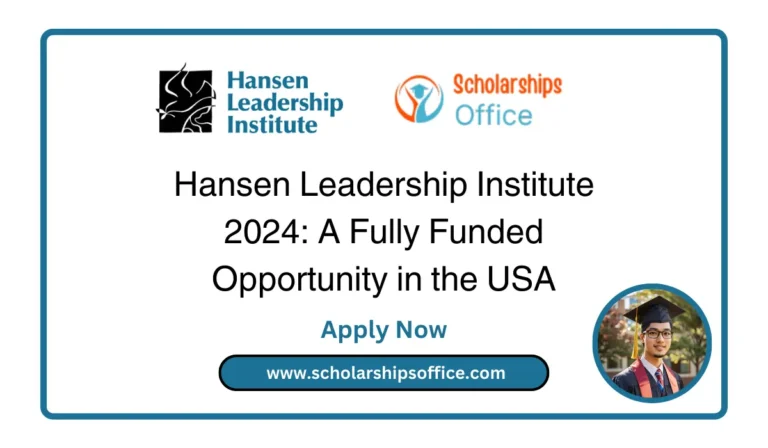
Hansen Leadership Institute 2024: A Fully Funded Opportunity in the USA
Are you a student looking for a fully funded leadership program in the United States? The Hansen Leadership Institute (HLI) offers a unique 3-week exchange program in San Diego, California focused on conflict resolution, social entrepreneurship, public speaking and more. Key Takeaways The Hansen Leadership Institute aims to foster global cooperation and cultural exchange between…

How to Write a Scholarship Motivation Letter in 2023
Got No Time? A Quick Answer for you The key to writing an effective scholarship motivation letter is to tailor your letter to the specific scholarship, highlight your most relevant qualifications, and explain how the scholarship will help you achieve your academic and career goals. Make sure to follow proper letter formatting, open with an…

How To Get Scholarship In Usa From Ethiopia? The Ultimate Guide
Getting a scholarship to study in the USA as an Ethiopian student requires research, preparation, and perseverance. Key steps include looking into scholarships offered by US universities, organizations, and government programs; meeting eligibility criteria; submitting strong applications with documents like transcripts, essays, and recommendations; and thoroughly completing all required paperwork. With dedication and strategic planning,…

How to Write an Outstanding Motivation Letter for a Scholarship Application
Got No Time? A Quick Answer for you:A motivation letter, also known as a personal statement, is a key part of any scholarship application. To write an effective motivation letter, start by researching the scholarship and university to tailor your letter. Use the introduction to grab the committee’s attention and clearly state your goals. In…

How To Write an Erasmus Motivational Letter in 5 Easy Steps
Got No Time? A Quick Answer for you:Writing a compelling Erasmus motivational letter is crucial for getting selected for the program. Follow these key steps – brainstorm your motivations, introduce yourself, explain why you chose the university/city, summarize your goals, and carefully proofread. Highlight your academic achievements, share details on the courses or research you…

Australia Accredited Sponsors for 482 Work Visa Sponsorship (2023)
Getting a work visa for Australia can be a complicated process, but finding an accredited sponsor can simplify things greatly. In this comprehensive guide, we’ll cover everything you need to know about Australia Accredited Sponsors for 482 Work Visa Sponsorship in 2023. Key Takeaways: Finding an accredited sponsor is a critical first step for the…
Leave a Reply Cancel reply
Your email address will not be published. Required fields are marked *
Save my name, email, and website in this browser for the next time I comment.
How to Write a Cover Letter for Scholarship
Learn how to showcase your skills and personality in your scholarship cover letter and increase your chance of becoming a top applicant by reading our guide!

Article highlights
A scholarship cover letter is a crucial part of most scholarship applications. A well-written cover letter can have a significant impact in the decision-making process as it is your chance to showcase your unique experience and personality. In this article, we'll go over everything you need to know to write a great scholarship cover letter.
What is a scholarship cover letter?
A scholarship cover letter, also called a letter of motivation, is a letter you write to the scholarship committee to request their consideration for a grant and persuade them that you are a deserving candidate for the scholarship. The main intention is to highlight your academic accomplishments and academic record .
In this letter, you should showcase your strengths and skills in a way that explains why you are a great candidate for the scholarship. Also, this is your chance to provide a more detailed overview of your academic and extracurricular achievements and interests that may not be covered in a CV or resume .
3 reasons to write a scholarship cover letter
1. it can help make your application stand out.
Academic scholarships are extremely competitive so you need to make sure you do everything in your power to be considered. Here's where a scholarship cover letter steps in. Scholarship committees receive numerous applications from students with straight A's, extensive lists of extracurriculars, and high exam grades. Use your cover letter to stand out and explain why you should win the grant .
2. It allows you to communicate your future plans
For institutions and foundations, a scholarship is an investment, thus naturally they want to be confident that it will pay off. That's why outlining how a particular grant aligns with your future research or work plans can make you a top applicant.
3. It can demonstrate your level of English
The majority of scholarships for international students expect the applicants to have high English proficiency . Most of the time, they require you to attach a certificate to your application. But even then, seeing your level of language skills in a scholarship cover letter can win you some additional points. However, it's important not to go overboard - remember this isn't an artistic essay.
Different forms of scholarship cover letters

Apart from the standard scholarship cover letter, particular scholarships may require you to submit information about yourself in a different form. It can be:
- a personal statement , which is meant to tell who you are as a person, your interests and motivations;
- a motivation letter , which communicates why you chose a particular program or scholarship, as well as how you fulfill the requirements;
- an essay , which typically answers one specific question about you;
- a form or a document with a few questions , where you'll have to answer specific questions (which may or may not cover the information you'd usually provide in a cover letter).
How to write a cover letter for scholarship: step-by-step guide
The main purpose of a scholarship cover letter is to showcase your strengths and goals and why those make you a great match for the grant. Here's a step-by-step guide to help you write a cover letter for scholarship:
Review the scholarship’s application requirements
Before writing your cover letter for a scholarship, always check the application requirements . Every scholarship can have different expectations, some applications even have specific questions they want you to answer, so make sure to do thorough research to tailor your cover letter to a specific grant .
This can give you a better idea of what to include in your application and highlight the experiences and skills that are not included in your resume but may increase your chances of being the winner.
Write an introduction
The introduction is where you can make a positive first impression on the scholarship committee and let them get to know you. In the introductory paragraph, you should cover:
- who you are,
- how you learned about the scholarship,
- why it sparked your interest.
Avoid using generic phrases and templates, and adjust your introduction to better fit the specific scholarship you are applying for.
Highlight your professional experience and internships
In the first body paragraph, you should highlight relevant skills and achievements and your professional experience and internships . Depending on the scholarship requirements, choose suitable experiences from your previous education and explain how they allowed you to gain knowledge and skills related to a particular field. This can demonstrate your learning style and commitment to personal growth.
Share your academic ambitions and interests
Describe your academic interests and ambitions in the next body paragraph. Generally, scholarships search for potential and want to help promising students to pursue their interest in academia. So keep in mind that scholarship committees may look for candidates with academic aspirations and ambitions .
Talk about your aspirations post-graduation
It is also important to talk about your post-graduation aspirations and long-term goals. Whether you want to continue your education or enter the industry, show the reviewing committee how this scholarship is a good investment in your future. Highlight how this funding could impact your career post-graduation.
Summarize your goals and credentials with a conclusion
Restate your interest in the scholarship and why you are a great candidate in the last paragraph of your scholarship cover letter. You can include your contact information and encourage the reviewing committee to reach out to you. This is also a good place to express gratitude for considering your application.
Proof-read and update your cover letter
Always check for spelling, grammar, and punctuation mistakes at least twice as they can point to a lack of attention to detail. Consider asking someone else , ideally, a professor, to review it and provide their insights and feedback . This way you can avoid missing any errors and adjust your tone and writing style .
Tips for writing a scholarship cover letter
Here are some other important things you should keep in mind while writing a scholarship cover letter:
Make your cover letter unique and personal to your interests and achievements
The reviewing committee has gone through many cover letters, having seen those generic templates and patterns numerous times. This is a chance for you to make your cover letter personal and unique . Describe your specific goals, showcase your personality, and provide all relevant information that can help you stand out.
Format your letter in a professional manner and check for errors
Match your letter to the recommended formatting to make it look more professional:
- use a simple font and an appropriate size
- check the margins on the sides of the pages
- check the spacing between the lines
- try to make it one page long (unless a different length is specified)
Always double- or triple-check for spelling mistakes . According to Forbes , typos and grammar mistakes are among the top 5 reasons why many students have their applications rejected.
Include quantifiable accomplishments
Choose quantifiable achievements that reflect the criteria related to applicants' skills and accomplishments. It helps the reviewing committee determine how you compare to other candidates . Consider including your grade average, your most notable project, and numerical data that demonstrates your performance in relevant academic and extracurricular activities.
Don’t forget to provide evidence to back up your points
It is helpful to refer to evidence to support your points. For example, you may consider mentioning the specific source of your skills or situations where you have successfully applied them. It's best to avoid including any information that cannot be backed up .
Here's a piece of advice from Swedish Institute Scholarship recipient Suci Ariyanti :
Be honest. Never give false information, or exaggerate things. Not only will the SISGP committee do random checks on applicants, but it is also important to keep your integrity intact.
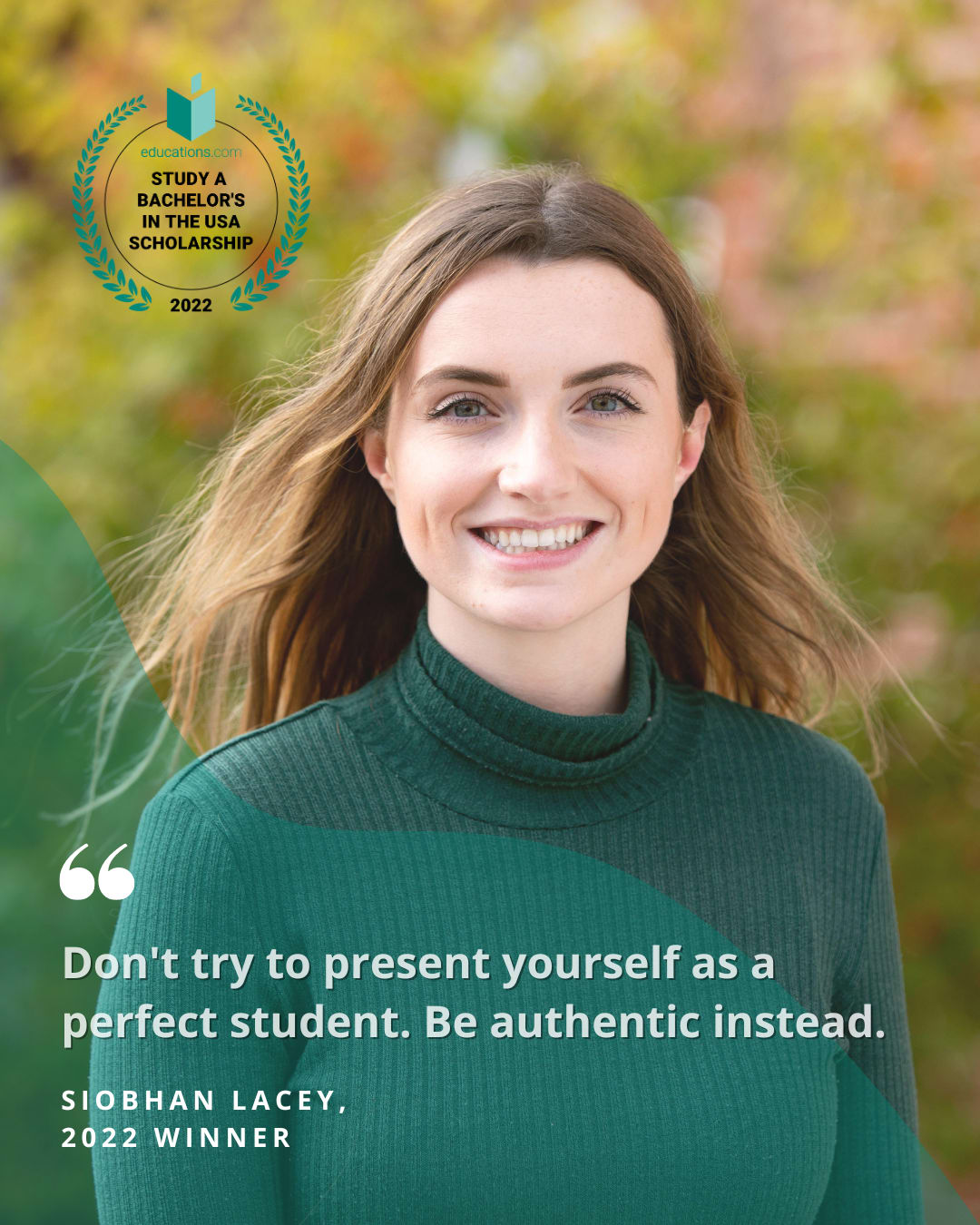
New scholarships from Educations.com
Women scholarship for international students 2024.
Application deadline: 25 August 2024 at 12:00 CEST

This $5,000 Women scholarship for international students will be awarded to globally-minded female students beginning their undergraduate, graduate, or post-graduate studies in the Fall 2024 semester or after. The award is meant to help cover your tuition fees and share your unique story as a woman with the world!
Undergraduate in STEM Scholarship 2024
Application deadline: 13 October 2024 at 12:00 CEST

Our STEM degree scholarship will be awarded to students starting their STEM studies in the Fall 2024 semester or later and is worth up to $5,000 . Students from all countries who will be studying for an undergraduate STEM degree abroad at a college or university can apply for this scholarship. We believe that students who study abroad become the next generation of globally-minded adventurers – so we want to help more of you reach your potential.
Graduate Study in the USA Scholarship 2024
Application deadline: 22 September 2024 at 12:00 CEST

Graduate Study in the USA scholarship is our first ever Master's degree scholarship . Students beginning their studies in the Fall 2024 semester or later can be awarded up to $5,000. It's open to international students from any country outside the USA who will be pursuing a Master's degree abroad at a college or university in the USA. It can be used to help cover tuition fees and get you one step closer to your next great adventure, in the USA.
More scholarships:
- Study a Master's in Europe Scholarship 2024
- Go Global MBA Scholarship 2024
- Study Abroad Scholarship Directory 2024
A scholarship cover letter gives you an opportunity to highlight your academic accomplishments and academic record and persuade the reviewing committee that you are a great candidate for the scholarship. Providing more information about you lets them get to know your personality and adds details to your application.
Make sure to spend enough time on this cover letter since it's a very important evaluation point during the decision-making process. Thoroughly research the requirements and tailor your letter to a specific scholarship . And don't forget that transparency is key , the selection committee aims to choose you for who you truly are!

Keystone Team Author
The Keystone Team is comprised of experienced educators and advisors dedicated to providing valuable resources and advice to students all over the world.
Published In: Letters
Scholarship Application Letter Samples (Writing a Strong Application)
Students sometimes face financial constraints challenges, making it hard for them to afford tuition fees as stipulated by their school of choice. Nevertheless, several colleges, universities, and organizations offer scholarships to eligible students to assist them financially. If you are unsure about how to write a strong Scholarship application letter, this article will be very useful to you. in this article, we have provided a step-by-step guide on how to write a killer scholarship application letter, several samples, and templates that are readily available for download for your reference.
What is a Scholarship Application Letter?
A scholarship cover letter is a useful document that allows applicants to express themselves and deliver details about their goals and abilities. The scholarship letter usually serves as a formal introduction to the scholarship committee in addition to identifying you as the prime candidate for the specific scholarship being offered and is accompanied by the sponsoring organization’s materials.
A candidate justifies himself/herself as an outstanding student in overall studies and extracurricular activities to increase their chances of getting the scholarship through a scholarship application letter.
Sections of a Scholarship Application Letter (Format)
A scholarship cover letter should have different sections and paragraphs, with each part serving a different role:
Introduction
Provide your contact information, e.g., full names, address, and telephone number. Briefly introduce yourself to the scholarship committee or individual and add a milestone achievement to draw their attention.
First Paragraph
Your introductory paragraph should focus on your educational and career goals. Discuss your interests and show passion in the chosen area of course work. Give the funding organization all the reasons to choose to invest in you and help further your education. In simpler terms, show your worth.
Second Paragraph
The second paragraph needs to focus on your strengths. If you have participated in any extracurricular activities or you have had your hands on any community work, include it in this paragraph. Any academic accolades and awards should also be listed in this section. The second paragraph is usually all about selling yourself and your capabilities to the decision-makers of a scholarship.
Third Paragraph
In this section, talk about why it should be considered for the application. Speak directly to the individual or organization that is handling out the money in a professional manner. However, refrain from acting desperate for money, but rather, desperate for education. It is not wrong to talk about books, food, housing, and other school costs.
You can add the fourth paragraph if there is much to talk about.
Call to action paragraph
This is the last paragraph of your letter. Close strongly by highlighting any talents or special skills you possess and letting the funding company or individual feel confident that the course work will be completed. Restate your educational and career goals, and include a call-to-action statement.
Length of your cover letter
The letter should be around 1-2 pages maximum. Use font 12 and double spacing to make it easy to read through.Proofread your letter for clerical errors to ensure it is perfect.
How to Write
Cover letters written for scholarships may break or increase your chances of getting the scholarship you badly need. These letters are not very different from job application letters, but the idea is to market your capabilities to the scholarship providers. Thus, as a student in need of a scholarship, you need to understand how to write a good cover letter to improve your personal goals. The following are some tips on how to write an appealing scholarship application cover letter.
Explain why you are a good match for the scholarship
A well-written scholarship cover letter is an opportunity for you to overview your main strengths from an educational and professional point of view, your career development goals and plans, why you would be suitable for this scholarship, and how it will benefit you if selected. Ensure that you cover all this information using specific examples where possible.
Use a formal tone, a clear structure, and check spellings
Use a formal tone to write your scholarship application cover letter and employ a clear, concise, structured flow. Make sure to check and correct any spelling and grammar mistakes. Try asking another person with an objective eye to proofread your cover before submitting it to ensure you did a successful one. This also allows you to minimize the risk of any grammatical or spelling errors and helps you remove any unclear, redundant, or irrelevant information.
Match your cover letter to the context
Certain situations of scholarship applications require you to attach a cover letter. During the same time, you might be applying for admission to a program or an institution, or you may be applying for a grant or scholarship to cover your tuition fees or any other costs related to a program you have already been accepted to.
If your scholarship letter is intended for the initial case, begin your letter with a formal address and greetings, then do a short paragraph explaining your academic skills, strengths, and achievements. Your second paragraph should explain why you need the scholarship to fund your studies. The third paragraph should describe how the given program, project, or course you are applying for will help you meet your goals and objectives and how you will contribute during your studies. Your closing should be polite and formal.
If you are applying for funding for a program you have already been admitted to, consider these few aspects.
- Use a formal address and greetings, then a brief paragraph emphasizing your academic skills.
- The second paragraph should emphasize your financial situation and the reasons prompting you to need the funding
- Your third paragraph should be about your interest in studying in that particular institution and how much value you will get from it,
- Conclude your cover letter strongly by highlighting your strengths, academic skills, and goals to ensure your success.
What “NOT” to Include in your Letter
- Avoid adding your weaknesses: Do not mention any of your weaknesses. Since many people will be sending in their applications every day, you don’t want to come off as the weaker applicant, thereby reducing your chances of landing the scholarship.
- Don’t use an informal tone. Always be professional when writing the letter. You don’t know who will be reviewing your application, so make sure that you stick to a formal tone.
- Never submit your cover letter before proofreading. After drafting your letter, make sure to go through it several times to ensure it is free of any errors and that every detail is well captured.
- Avoid adding unnecessary or untrue information: Since you are trying to sell yourself, don’t exaggerate too much. At times, honesty is the best policy. Don’t lie; be simple and straight forward in your writing.
- Do not hide your need for financial aid: Remember why you are writing the application. Do not be embarrassed to ask for help.
Scholarship Application Letter Templates & Samples
Whether you are writing a scholarship application letter to gain admission to a university or college, appeal for financial assistance, or apply for further postgraduate studies, you can download and use our Free and premium templates and quickly customize them to fit your specific needs and objective. Download our templates today and get started on your scholarship application.
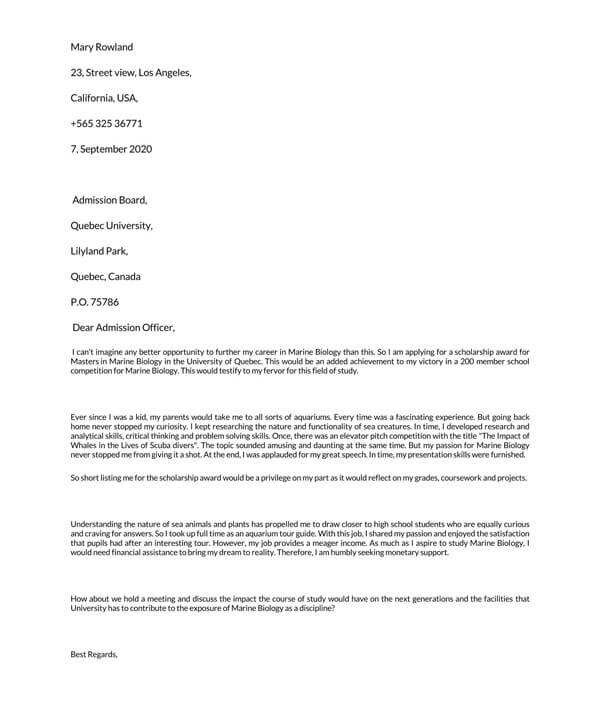
What do Scholarship Committees Require from Applicants?
Generally, scholarship committees look for some or all the following qualities in an ideal applicant.
- Candidate’s motivation and seriousness in the chosen field of study
- A detailed description of the specific course work or area of study
- The creativity and originality of the letter
- Leadership skills of the candidate as well as their emotional stability
- An applicant’s ability to collaborate with others and the desire to excel.
Tips for a Strong Application Letter
Here are a few tips to help you write a strong scholarship application letter:
- Explain why you are the perfect candidate for the scholarship: remember that you are trying to convince the scholarship committee that you are the perfect candidate for the scholarship. Convince them why they should choose you.
- Use a formal tone when writing and ensure that your letter has a clear structure and is free of any grammatical errors
- Write a great cover letter to go with your application letter: After drafting your application letter, write a great cover letter to act as an introduction and an invitation to review your application.
Many students fall under the category of those who are eligible for a scholarship. They may have excellent academic transcripts, or a list of extracurricular activities to boast about or a list of talents and hobbies. Whether you have those things or not, scholarship committees look for something else. That is students who have overcome challenges and major struggles, students who are leaders in their community, and those who have hobbies. It is a great idea to submit a scholarship application letter as it is your opportunity to think about how you can make yourself stand out from the other applicants and be selected for that scholarship sponsorship.
Related Documents
- Search All Scholarships
- Exclusive Scholarships
- Easy Scholarships to Apply For
- No Essay Scholarships
- Scholarships for HS Juniors
- Scholarships for HS Seniors
- Scholarships for College Students
- Scholarships for Grad Students
- Scholarships for Women
- Scholarships for Black Students
- Scholarships
- Student Loans
- College Admissions
- Financial Aid
- Scholarship Winners
- Scholarship Providers

Apply to vetted scholarship programs in one click
Student-centric advice and objective recommendations.
Higher education has never been more confusing or expensive. Our goal is to help you navigate the very big decisions related to higher ed with objective information and expert advice. Each piece of content on the site is original, based on extensive research, and reviewed by multiple editors, including a subject matter expert. This ensures that all of our content is up-to-date, useful, accurate, and thorough.
Our reviews and recommendations are based on extensive research, testing, and feedback. We may receive commission from links on our website, but that doesn’t affect our editors’ opinions. Our marketing partners don’t review, approve or endorse our editorial content. It’s accurate to the best of our knowledge when posted. You can find a complete list of our partners here .
How to Write a Scholarship Cover Letter

Gabriel Jimenez-Ekman is a content editor and writer at Scholarships360. He has managed communications and written content for a diverse array of organizations, including a farmer’s market, a concert venue, a student farm, an environmental NGO, and a PR agency. Gabriel graduated from Kenyon College with a degree in sociology.
Learn about our editorial policies

Maria Geiger is Director of Content at Scholarships360. She is a former online educational technology instructor and adjunct writing instructor. In addition to education reform, Maria’s interests include viewpoint diversity, blended/flipped learning, digital communication, and integrating media/web tools into the curriculum to better facilitate student engagement. Maria earned both a B.A. and an M.A. in English Literature from Monmouth University, an M. Ed. in Education from Monmouth University, and a Virtual Online Teaching Certificate (VOLT) from the University of Pennsylvania.
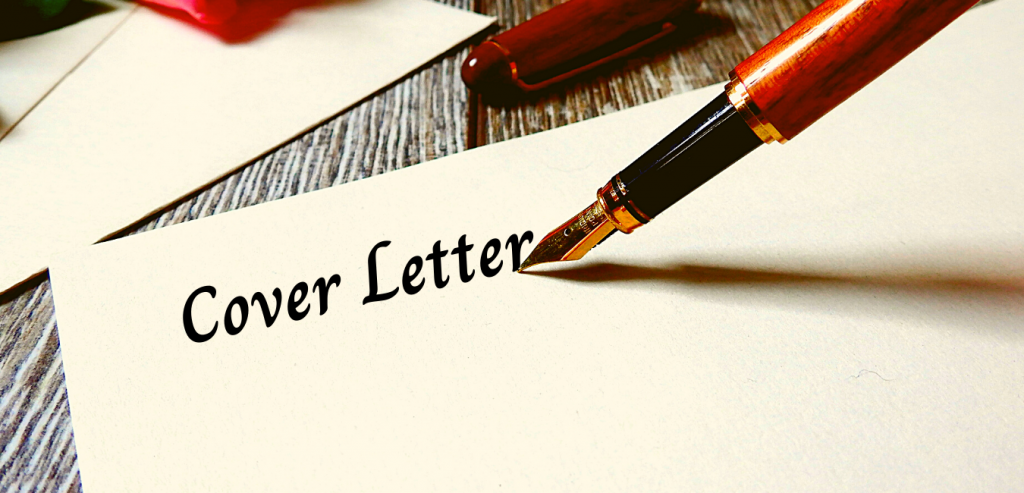
Scholarship cover letters might seem intimidating, but they should not deter you from applying for scholarships. Sometimes, students are intimidated because they don’t know how to write a scholarship cover letter. The following guide includes a thorough description of what you should address in the letter and how to format it.
First, let’s talk about the most fundamental question: what’s the ultimate goal of the cover letter?
Goals of a scholarship cover letter
Create a personal appeal by letting your voice come through.
Most scholarship applications largely consist of forms and checklists, but cover letters are a great opportunity for the reader to hear you make your case in your own voice. While you should still maintain a formal tone, you should not be afraid to write personably.
Emphasize the importance of your accomplishments
Resumes and application forms are great opportunities to describe your duties at past positions you’ve held, but a cover letter is a great opportunity to go one step further.
Describe the skills developed in your past positions
Think about how past learning experiences helped shape your ambitions. For example, if you had an internship in the office of a local government official, you could use your cover letter to describe how your experiences helped hone your organizational skills and shape your sense of civic duty.
- Share what you hope to pursue and build upon
How will you work towards your future goals and build upon your past experiences? Scholarship readers want to award their funds to students with a strong sense of ambition and an exciting future. Emphasize that you have big plans for the future, and how you will use the scholarship to accomplish them.
Highlight circumstances not addressed in the scholarship application
For example, if you have community service experience, but there was not a question in the application that allowed you to mention that, a cover letter is a great place to bring it up. This may not be specifically relevant to the scholarship, but speaks to your character and can help put you ahead of the crowd.
Start your scholarship search
- Vetted scholarships custom-matched to your profile
- Access exclusive scholarships only available to Scholarships360 members
Differences between a scholarship cover letter and a scholarship essay
Scholarship essays and cover letters have a lot in common:
- They are both opportunities to write about your future ambitions and show how you have reflected on your past experiences.
- Both allow you to make a personal appeal to your reader, and to bring up relevant information that was left out of the rest of the application.
However, while there is a lot of overlap between scholarship cover letters and scholarship essays, there are a few key differences:
- Scholarship essays are written in response to a prompt, but scholarship cover letters do not have an explicit prompt. For students who are used to prompts, this can be a stumbling block.
- One way to help overcome this open-endedness is to imagine the prompt as: “ Tell me about yourself and why you would be a good fit for this scholarship. ” Remember, the goal of a scholarship cover letter is to introduce yourself and to make a compelling case for your candidacy while highlighting assets not showcased in the rest of your application.
- Another key difference is in formatting; there are specific formatting rules for a scholarship cover letter, which we will cover below.
See also: How to write a winning scholarship essay
Formatting tips
While everyone’s cover letter is different and some scholarships may have specific requirements, here are a few general formatting tips to make your cover letter a success:
- Cover letters should be 1 page long, and it can be beneficial to break them down into small paragraphs to help the reader digest them more easily.
- They should also include a header with the date, your name and address, as well as your email and/or phone number.
- After the header, skip a line, and write the date.
- Skip another line, and include the name and title of the person you are addressing the letter to, and the address of the organization if available.
Some scholarships will list the name that the letter should be addressed. If you can’t find the name easily, try doing a bit of research to see if you can find the name of the person who will be reading your application. This can help put you ahead of your competition by showing that you did some additional research.
If you can’t find a name, you can skip that part of the header and write: “Dear selection committee” in your introduction. Here is an example header for someone who was able to find the name of their application reader:
James Wright 580 Chase Ln New Meadows, ID 83654 [email protected]
March 12, 2021
Ms. Carol Smith Better Business Bureau 12639 W Explorer Dr Boise, ID 83713
Dear Ms. Smith,
I am writing… ____________________________________________________________
Good luck writing your scholarship cover letter! Be sure to apply to all the scholarships you qualify for. Remember, there are scholarships for all demographics, including for women , high school seniors , and Black students. Some scholarships require essays and applications, but others are no-essay or easy to apply for scholarships . Remember, Scholarships360 is here to provide valuable resources and access to scholarships for students!
Key Takeaways
- Create personal appeal by letting your unique voice come through
- Emphasize the importance of your accomplishments and describe the skills learned in your past positions
- Highlight circumstances not addressed in your scholarship application
- Be mindful of any specific requirements when crafting your cover letter
Scholarships360 Recommended

Top 62 No Essay Scholarships in April 2024

Top 246 Scholarships for High School Juniors in April 2024

$20k in Exclusive Scholarships from Scholarships360
Trending now.

Top 46 Easy Scholarships✅ to Apply For in April 2024

Top 1,279 Scholarships for High School Seniors in April 2024

Top Scholarships for Current College Students in April 2024
3 reasons to join scholarships360.
- Automatic entry to our $10,000 No-Essay Scholarship
- Personalized matching to thousands of vetted scholarships
- Quick apply for scholarships exclusive to our platform
By the way...Scholarships360 is 100% free!
- Scholarship Letters
How To Write A Scholarship Application Letter
- 6 minute read

- November 30, 2023
- No comments
Although writing a scholarship application letter may seem daunting, the awarding committee will be able to learn more about you and your qualifications, making it a surefire way to win a scholarship. In this article on how to write a scholarship application letter, we’ll cover format, organization, and essential content, along with several best practices.
How to Write a Scholarship Application Letter
In order to apply for a scholarship, candidates might need to write a letter outlining why they want the scholarship in particular and how it will help them achieve their goals in school and the workplace. Scholarship committees are still keen to hear about your experiences and goals, but it’s critical that your cover letter stays concise and includes all the necessary details. Follow these steps to learn how to write a scholarship application letter:
Check the scholarship’s eligibility requirements.
The standards, prerequisites, and preferences of the scholarships you apply for differ. Examine the particular requirements of every scholarship you are thinking about in detail . This aids in evaluating your chances of winning the scholarship and advising you on what details to include in your application to pique the committee’s interest. Address any skills or experiences you have that aren’t listed on your resume or transcript in your scholarship application letter.
Write a summary of your letter of application for a scholarship.
Start writing your letter with an introduction that provides pertinent details about yourself, your application’s purpose, and your interest in the organization’s scholarship. Talk about how receiving this funding could give you access to educational opportunities that you otherwise wouldn’t have, and describe how the organization relates to your goals both academically and professionally. This is significant because enhancing the educational potential of individuals facing financial obstacles is a common goal of numerous scholarships.
Give a brief introduction of yourself, mentioning your training, any programs you’re interested in, and the degree you’re working toward. It is acceptable to use the opening paragraph to convey your enthusiasm for your academic career. This helps the people on the review committee learn more about your interests and personality.
Write about your work experience, including internships.
In the first part of the body, write about any prior employment or internships. Stress the connection between these experiences and the scholarship or your educational objectives. Assume that the purpose of the scholarship is to encourage students to pursue careers in STEM. In that scenario, a sample would be to discuss your experience working as a laboratory intern and how this program helped you gain the knowledge and abilities necessary to earn a biology bachelor’s degree.
Review committees continue to favor candidates who are dedicated to furthering their careers. Emphasize your ability to push yourself by discussing your work experience and making connections between your personal traits and your field of study.
Describe your long-term academic goals and areas of interest in the classroom.
Use the next paragraph as space to talk about your goals and areas of interest in academia. Scholarships are frequently given to students to help with their educational costs. This indicates that people with clear academic objectives continue to be of special interest to the evaluating committee. In this paragraph, describe the degree that piques your interest or provide evidence for why a specific program or organization would be the ideal match for your goals.
Submit an application for admission to a university, apply for a scholarship, and ask a school for additional funding. As an alternative, apply to an outside organization for an award. In your scholarship cover letter, try to highlight how the funding will help you achieve your educational goals even if you are unable to meet certain requirements because of a lack of funds.
Examine your goals for after graduation
Talk about your post-graduation plans in addition to your relevant work experience and short-term academic goals. By discussing your goals and aspirations with you, the scholarship committee gains a deeper understanding of them.
It makes no difference if your goals are to work toward a professional license, earn a graduate degree, or enter the workforce. A scholarship awarding organization’s financial support represents an investment in students’ futures. Therefore, you benefit from emphasizing the potential long-term impact of obtaining monetary support on your academic and professional career after graduation.
Write your essay’s last paragraph
Conclude your scholarship application letter with a paragraph highlighting your career objectives and qualifications once you complete the three body paragraphs. Please use this space to thank the scholarship committee for their time and consideration. Remind the committee how much you appreciate the opportunity to apply for this particular award. Provide your contact details and ensure that the review committee members can access them in case they need to inquire about the status of your application or if they have any questions about your qualifications and information.
Edit and proofread your writing
Once you’ve finished a preliminary draft of your scholarship application letter, proofread it for spelling and grammar mistakes and make any necessary edits. To assess your tone and make sure it aligns with the scholarship awarding organization, choose to read the text aloud to yourself.
Asking a disinterested friend, mentor, or lecturer to read it and provide feedback on your writing project might be a good idea. They also help you assess your writing style and find any issues that you might have missed. They also highlight any information that should be removed from the scholarship application letter because it is superfluous or irrelevant. Having a flawless cover letter helps you prove to a potential employer or the reviewing committee that you’re serious about the application process.
Mistakes to Avoid
Now that you know how to write a scholarship application letter, here are the most common mistakes to avoid at all costs:
- Make sure there are no grammar or spelling mistakes.
- Don’t use informal language and empty clichés.
- Don’t be vague, and stay clear from generalizations. Every experience described should be relevant to your argument.
- Don’t write like you believe the scholarship is already yours; this will make you come off as entitled. Don’t angle for sympathy and beg for the scholarship, either. Let your achievements and logical argumentation do the work and persuade the reader.
An example of a scholarship application letter
Scholarships aren’t merely for offsetting the cost of higher education. Most scholarship providers remain genuinely interested in meeting their scholarship awardees and accompanying them on their course of study. To help you write, consider the following example of a scholarship application letter:
Dear Mr Davids,
My name is Richard Scott, and I’m a college student interested in applying for the Creative Arts Scholarship. I intend to attend the University of California, Berkley, and receive a bachelor’s degree in graphic design. Because of this grant, I’ll be able to pay for my first semester of university tuition and focus on my academic work without worrying about my financial position. As an honours student and the first-place winner of a national visual arts competition, I’m confident in my ability to compete for this scholarship.
Although I carry no professional experience connected to my passion for graphic design, I’m presently the president of the Art Club at my high school, where I’m responsible for several administrative and leadership responsibilities. College remains a time for me to broaden my knowledge of design software and learn new skills. I also plan to apply for professional internships that can help me obtain valuable job experience before I graduate and join the industry.
With financial assistance, I aspire to further my academic and professional career, pursue my hobbies, and build graphic design talents while remaining entirely focused on my education. I’m thrilled at the prospect of earning a degree that prepares me for my desired profession. Thank you for taking the time to read this application letter. For any follow-up inquiries or questions, please don’t hesitate to contact me by phone or email. Thank you for your time and consideration.
Kind regards,
Richard Scott
Although scholarship application letters usually have a predetermined format, there may be variations depending on the institution. Carefully review the instructions, then modify your plan of action to fit your particular application.
Additionally, keep in mind that the purpose of a scholarship is to advance organizations, scholars, and research. Your chances of success will rise if you can convince the scholarship committee that your proposal will benefit you just as much as your program and the department or organization giving it.
1. How much effort should I put into my application essay?
Well, as much as you can, of course. You’ll get into the flow of the process the more you write and apply. You may even be able to use a previous application as a template for your next. The key is to give each essay your all. After all, you want to win money here!
2. Do scholarship administrators care about spelling and grammar in my essay?
Yes, correct spelling and grammar are important. Your ideas are easier to convey and understand when written clearly, and you want to show the admin that you took the time to produce a quality piece of writing. Copious spelling and grammar errors send the opposite message.
3. Is it okay to re-use a scholarship application essay?
Yes, you can re-use an essay you wrote. Don’t plagiarize someone else, though! And be sure to read and re-read the application instructions, to be sure your work is applicable. You’ll probably need to tweak some details to make everything fit.
Leave a Reply Cancel reply
Your email address will not be published. Required fields are marked *
Save my name, email, and website in this browser for the next time I comment.
You May Also Like

- 4 minute read
How To Write An Effective Reference Letter For A Scholarship
- 10 minute read
Thank You Letter For Scholarship Donor Sample
- March 22, 2022

- 7 minute read
Why I Need A Scholarship
- Advice & Tips
Mastering the Art of Writing a Scholarship Application Letter (With Template)
March 18, 2024
Introduction
In today's competitive job market, both job seekers and employers face numerous challenges. Job seekers are constantly looking for ways to stand out from the crowd and secure opportunities that will help them advance in their careers. On the other hand, employers are seeking top talent that not only meets the job requirements but also brings unique qualities and experiences to the table.
One significant way for students to distinguish themselves and gain access to quality education is through scholarships. Scholarships provide financial assistance to students based on various criteria such as academic achievements, community involvement, or specific talents. However, with the increasing number of scholarship applicants, it has become crucial for students to craft outstanding scholarship application letters to increase their chances of receiving these coveted awards.
We understand the importance of a well-written scholarship application letter in helping students secure the financial support they need to pursue their academic goals. In this comprehensive guide, we will delve into the key components of a winning scholarship application letter, provide tips on crafting a standout letter, highlight common mistakes to avoid, and offer a sample template to get you started on the right track. Additionally, we will share expert advice on writing an effective scholarship application letter, present statistics on the importance of scholarships in the job market, explore international insights on how application letters differ across countries, and conclude with strategies to leverage your scholarship application letter for success.
Understanding the Importance of a Scholarship Application Letter
In today's competitive job market, pursuing further education through scholarships has become increasingly essential for many individuals. Scholarships can provide financial assistance to help students achieve their academic and career goals without being burdened by student loans. However, with numerous qualified candidates vying for limited scholarship opportunities, it is crucial to have a well-crafted scholarship application letter that sets you apart from the competition.
Why is a Scholarship Application Letter Important?
A scholarship application letter serves as your introduction to the scholarship committee or donor. It allows you to showcase your accomplishments, skills, and aspirations in a concise yet compelling manner. This letter provides insight into who you are beyond your academic transcripts and demonstrates why you are a deserving candidate for the scholarship.
Furthermore, a well-written scholarship application letter can help you stand out and leave a lasting impression on the selection panel. It gives you the opportunity to highlight your strengths, share your personal story, and articulate your goals clearly. Additionally, crafting a strong application letter shows your dedication, attention to detail, and professionalism – qualities that are highly valued by scholarship providers.
Benefits of a Strong Scholarship Application Letter
- Increases your chances of securing the scholarship
- Highlights your unique qualifications and experiences
- Demonstrates your communication and writing skills
- Allows you to express your passion for your field of study
- Shows your commitment to academic and career success
Whether you are a high school student applying for undergraduate scholarships or a graduate student seeking funding for postgraduate studies, a well-crafted scholarship application letter can make a significant difference in your educational journey.
Key Components of a Winning Scholarship Application Letter
When applying for a scholarship, your application letter plays a crucial role in highlighting your qualifications, achievements, and aspirations. To craft a compelling scholarship application letter, it is essential to include the following key components:
1. Introduction:
The opening paragraph of your letter should clearly state the purpose of your application and grab the reader's attention. Introduce yourself, mention the specific scholarship you are applying for, and briefly explain why you are a strong candidate.
2. Personalized Salutation:
Address the recipient of the letter using a personalized salutation. If possible, find out the name of the person or committee reviewing the applications and address them directly.
3. Academic Achievements:
Highlight your academic accomplishments, including your GPA, relevant coursework, honors, awards, and any extracurricular activities that demonstrate your dedication and passion for learning.
4. Financial Need:
Explain your financial situation and why you require financial assistance to pursue your education. Be honest and transparent about your circumstances, as many scholarships are awarded based on need.
5. Career Goals:
Outline your career goals and how receiving the scholarship will help you achieve them. Show your dedication to your chosen field of study and how you plan to make a positive impact in the future.
6. Leadership and Community Involvement:
Describe any leadership roles you have held, volunteer work you have done, or community service projects you have been involved in. Highlighting your commitment to serving others can set you apart from other applicants.

7. Letters of Recommendation:
Include letters of recommendation from teachers, mentors, or employers who can attest to your character, work ethic, and potential for success. These testimonials provide credibility to your application.
8. Closing Paragraph:
End your letter with a strong closing paragraph that summarizes your qualifications, expresses gratitude for the opportunity to apply, and reiterates your enthusiasm for the scholarship.
By incorporating these key components into your scholarship application letter, you can effectively convey your strengths, motivations, and aspirations to the selection committee. Remember to tailor each letter to the specific requirements of the scholarship you are applying for and showcase what makes you a deserving candidate.
Tips for Crafting a Standout Scholarship Application Letter
When it comes to securing scholarships, your application letter plays a crucial role in showcasing your qualifications and persuading the selection committee. Here are some expert tips to help you craft a standout scholarship application letter:
Highlight Your Achievements
Begin by outlining your academic achievements, extracurricular activities, and any relevant work experience. Make sure to emphasize how these experiences have shaped your goals and contributed to your personal growth.
Personalize Your Letter
Avoid using generic templates and instead tailor your letter to each scholarship opportunity. Research the organization offering the scholarship and ensure your letter aligns with their values and mission.
Show Your Passion
Demonstrate your passion for your field of study or the cause supported by the scholarship. Share personal anecdotes that showcase your dedication and commitment to making a difference in your chosen field.
Be Clear and Concise
Avoid using jargon or complex language that may be difficult for the selection committee to understand. Clearly articulate your thoughts and keep your letter concise and to the point.
Proofread Carefully
Before submitting your application, proofread your letter multiple times to check for spelling and grammatical errors. Consider asking a mentor, teacher, or friend to review your letter and provide feedback.
Address Selection Criteria
Ensure that your letter addresses all the criteria outlined in the scholarship application. Provide specific examples that demonstrate how you meet and exceed the expectations set by the committee.
Follow Instructions
Pay close attention to the application guidelines and ensure that you follow all instructions regarding formatting, word count, and submission deadlines. Failure to adhere to these guidelines may result in your application being disqualified.
By incorporating these tips into your scholarship application letter, you can increase your chances of standing out to the selection committee and securing the financial support you need to pursue your educational goals.
Common Mistakes to Avoid in Your Scholarship Application Letter
When applying for scholarships, it's crucial to present yourself in the best possible light to increase your chances of success. However, many students unknowingly make common mistakes that can negatively impact their applications. To help you avoid these pitfalls, here are some of the most frequent errors to steer clear of when crafting your scholarship application letter:
Lack of Personalization
One common mistake is failing to personalize your scholarship application letter. Recipients can often tell when a letter is generic and not tailored to the specific scholarship opportunity. Take the time to research the organization offering the scholarship and customize your letter to highlight how you align with their values and mission.
Poor Proofreading
Spelling and grammatical errors can significantly diminish the credibility of your application. Failing to proofread your scholarship application letter demonstrates a lack of attention to detail and can harm your chances of being selected for the scholarship. Always review your letter carefully or ask someone else to proofread it for you.
Lack of Focus
Another mistake is including irrelevant or excessive information in your scholarship application letter. Stay focused on the qualifications and experiences that directly relate to the scholarship requirements. Including too much extraneous information can detract from your key selling points.
Overly Formal Tone
While professionalism is essential, an overly formal tone can make your scholarship application letter seem stiff and impersonal. Aim for a balance between professionalism and warmth to convey your genuine personality and enthusiasm for the opportunity.
Failure to Follow Instructions
Many scholarship applications come with specific guidelines and instructions that must be followed precisely. Failing to adhere to these instructions, such as word limits or required documentation, can result in automatic disqualification. Pay close attention to the details outlined in the application and ensure you comply with all requirements.
- Avoiding these common mistakes can help you create a more compelling and competitive scholarship application letter.
By being mindful of these potential pitfalls and taking the time to craft a well-written and tailored scholarship application letter, you can enhance your chances of standing out to scholarship selection committees and securing the financial support you need for your education.
Sample Template for a Scholarship Application Letter
When applying for a scholarship, it's essential to craft a compelling application letter that highlights your qualifications, achievements, and aspirations. Here is a sample template to guide you through the process:
Full Name of Applicant
[Your Address]
[City, State, Zip Code]
[Email Address]
[Phone Number]
Date: [MM/DD/YYYY]
Scholarship committee.
[Scholarship Name]
[Address of the Committee]
Dear Members of the Scholarship Committee,
I am writing to apply for the [Name of the Scholarship] to further my studies in [Your Field of Study]. As a dedicated and driven student, I believe that this scholarship opportunity aligns with my academic goals and future career aspirations.
Introduction:
Begin by introducing yourself and stating the purpose of your letter. Mention the specific scholarship you are applying for and express your enthusiasm for being considered for it.
Educational Background:
Provide a brief overview of your academic achievements, including your GPA, any honors or awards received, and relevant coursework. Highlight any extracurricular activities or leadership roles that demonstrate your commitment to personal and academic growth.
Career Goals:
Share your career objectives and how receiving this scholarship will help you achieve them. Explain how your chosen field of study relates to your future professional endeavors and how you plan to make a positive impact in the industry.
Financial Need:
Briefly explain your financial situation and why you require this scholarship to pursue your education. Be transparent about any challenges you may face in funding your studies and how the scholarship would alleviate some of those burdens.
Conclusion:
Summarize your key points and reiterate your gratitude for the committee's consideration. Express your eagerness to contribute to the academic community and make a difference in your field.
[Your Full Name]
[Your Signature - if submitting a physical copy]
Remember to customize this template to reflect your unique experiences and achievements. Personalizing your scholarship application letter will increase your chances of standing out to the selection committee. Good luck!
Expert Advice: Top Tips for Writing an Effective Scholarship Application Letter
1. showcase your achievements.
According to Jane Smith, founder of Scholarly Minds Consulting, "Highlighting your academic accomplishments is crucial in a scholarship application letter. Make sure to showcase your achievements in a way that aligns with the values of the scholarship provider."
2. Tailor Your Letter to Each Scholarship
"Personalization is key," says Michael Johnson, CEO of ScholarSelect Solutions. "Tailor each application letter to the specific scholarship you are applying for. Show the selection committee that you have taken the time to understand their mission and how you can contribute to it."
3. Tell Your Story Authentically
"Authenticity can set your application apart," emphasizes Maria Rodriguez, Scholarship Coordinator at Dream Big Foundation. "Share your personal story and motivations behind seeking the scholarship. Let your genuine passion and drive shine through in your writing."
4. Demonstrate Your Future Goals
Sarah Evans, Director of ScholarPro Services, advises, "Clearly articulate your future goals and how receiving the scholarship will help you achieve them. Conveying a clear vision of your aspirations shows the committee that you are committed to making a difference."
5. Seek Feedback and Proofreading
"Don't underestimate the power of feedback," recommends David Lee, Head of Admissions at CollegePrep Experts. "Seek input from mentors, teachers, or advisors to refine your letter. Additionally, ensure your application is error-free by thorough proofreading."
6. Follow Instructions Carefully
"Adhering to guidelines demonstrates your attention to detail," states Emily Chen, Scholarship Coach at Future Scholars Network. "Whether it's word count, formatting, or submission requirements, make sure to follow the instructions provided by the scholarship committee to the letter."
7. Emphasize Community Involvement
"Showcasing your engagement in community service and extracurricular activities can strengthen your application," suggests Alex Thompson, President of ScholarCommune. "Highlight how you have made a positive impact in your community and how you plan to continue giving back in the future."
8. Express Gratitude
"Don't forget to express gratitude for the opportunity to apply for the scholarship," says Kimberly White, Scholarship Advisor at Brighter Futures Fund. "Conveying appreciation towards the scholarship providers demonstrates humility and leaves a positive impression."
Statistics on the Importance of Scholarships in the Job Market
Scholarships play a crucial role in shaping the job market by providing opportunities for individuals to further their education and skills. Let's delve into some compelling statistics that highlight the significance of scholarships in the professional landscape.
Average Scholarship Amounts:
In the United States, the average scholarship or grant aid received per student is approximately $7,670. This financial support significantly impacts students' ability to pursue higher education and enter the job market with reduced financial burden.
Employment Rates of Scholarship Recipients:
Research indicates that individuals who have received scholarships are more likely to secure employment compared to those who did not receive financial aid. Scholarship recipients demonstrate a drive for success and commitment to their academic and professional growth.
Diversity and Inclusion:
Statistics show that scholarships play a vital role in promoting diversity and inclusion in the job market. Organizations that offer scholarships aim to create equal opportunities for individuals from various backgrounds, leading to a more diverse and enriched workforce.
Impact on Career Advancement:
A significant percentage of professionals attribute their career advancement to receiving scholarships during their educational journey. These individuals acknowledge the pivotal role that financial assistance played in helping them acquire the necessary skills and qualifications for career progression.
Investment in Future Talent:
Employers recognize the value of supporting scholarship programs as a means to invest in future talent. By contributing to scholarships, companies not only foster learning and development but also gain access to a pool of skilled individuals who can positively impact their organizations.
Retention and Employee Satisfaction:
Studies reveal that employees who have benefited from scholarships exhibit higher levels of job satisfaction and loyalty towards their employers. The investment made by companies in supporting employees' educational pursuits often results in enhanced retention rates and a motivated workforce.
These statistics underscore the profound impact that scholarships have on both individuals seeking to enter the job market and employers looking to attract top talent. By fostering a culture of continuous learning and professional development through scholarships, the job market experiences positive transformations that benefit society as a whole.
International Insights: How Scholarship Application Letters Differ Across Countries
Scholarship application letters play a crucial role in the selection process across various countries, each with its own unique expectations and norms. Understanding these international differences can help applicants tailor their letters effectively. Let's explore how scholarship application letters differ across countries.
United States
- In the US, scholarship application letters should be concise, well-structured, and highlight the applicant's achievements and aspirations.
- Emphasis is placed on showcasing leadership skills, community involvement, and future goals.
- Providing specific examples and anecdotes to support claims is highly encouraged.
United Kingdom
- UK scholarship letters typically require a formal tone and adherence to traditional writing conventions.
- Applicants are expected to demonstrate a clear understanding of their chosen field of study and its relevance to their career objectives.
- Personal experiences and challenges faced by the applicant can add depth to the letter.
- Australian scholarship application letters often focus on the applicant's academic achievements, research interests, and potential contributions to the field.
- Emphasizing the alignment between the applicant's goals and the values of the institution or organization offering the scholarship is key.
- Highlighting any relevant work experience or extracurricular activities can strengthen the application.
- In Canada, scholarship letters should be structured logically, with a clear introduction, body, and conclusion.
- Applicants are encouraged to articulate how receiving the scholarship would enable them to make a positive impact on their community or society.
- Citing mentors, professors, or past experiences that have shaped the applicant's academic journey can resonate with selection committees.
It's essential for applicants to research the specific requirements and cultural expectations of the country they are applying to. Adapting the tone, content, and structure of the scholarship application letter accordingly can significantly enhance the chances of success.
Writing a compelling scholarship application letter is a crucial step in securing financial support for your education and future career endeavors. By following the key components, tips, and expert advice outlined in this guide, you can enhance your chances of standing out among the pool of applicants and increase the likelihood of being awarded a scholarship.
Key Takeaways:
- Personalization is Key: Tailor your application letter to each scholarship opportunity to demonstrate your genuine interest and fit for the program.
- Showcase Your Achievements: Highlight your academic accomplishments, extracurricular activities, and community involvement to showcase your well-rounded profile.
- Emphasize Your Goals: Clearly articulate your educational and career goals, emphasizing how the scholarship will help you achieve them.
- Proofread Carefully: Ensure your letter is free of errors, is well-structured, and follows the specified guidelines and word count limits.
- Seek Feedback: Before submitting your application, have trusted individuals review your letter to provide constructive feedback and suggestions for improvement.
Remember that scholarships are highly competitive, and a well-crafted application letter can be the deciding factor in whether you receive the financial assistance you need. Utilize the sample template provided and tailor it to your unique experiences and aspirations to make a compelling case for why you deserve the scholarship.
Investing time and effort into crafting a standout scholarship application letter is an investment in your future success. By showcasing your passion, qualifications, and aspirations effectively, you can increase your chances of receiving the financial support you need to pursue your academic and professional dreams. Good luck!

- Applying For Scholarships
Write a Killer Cover Letter for a Scholarship in 2023 (w/Example)
David Jul 24, 2022

Get our best scholarship practices, insights & tips delivered to your inbox
Thank you for subscribing!
It’s easy to get put off by scholarship applications that require a cover letter. Cover letters may seem annoying but there is a bright side here. A simple letter gives you another opportunity to convince the scholarship committee that you deserve to win the award.
So how do you start? What should you include in the letter? How should you end it? In this post, we’ll answer all these questions and we’ll even provide a sample letter that you can use as a template in the end.
What Is a Cover Letter?
Let’s start with the basics. A cover letter for a scholarship is similar to a cover letter you’d submit for a job . What does that mean exactly?
It’s simply a letter you write to the scholarship committee. In the letter you should explain what makes you a great candidate for the award. You should also talk about how the scholarship will help you reach your educational and career goals .
The fastest path to earning scholarships
Simplify and focus your application process with the one-stop platform for vetted scholarships.
The scholarship committee wants to find the most fitting students to invest their money in. Make them see the reasons why they should they invest in you.
Why a Cover Letter?

Whether you have those things or not, many scholarship committees look for something else. They look at students who have overcome struggles. Students who are leaders in their community. And students who have unique hobbies. Your cover letter is the place to show off your unique self.
Although not every scholarship application requires students to submit a cover letter, when they do, it’s a great idea to submit a great one. Use the opportunity to think about how can you make yourself stand out from other applicants. What is unique to you that other applicants don’t have? Brainstorm and show it off!
What Should Your Cover Letter Accomplish?
Your cover letter should do the following:
- Highlight your strengths: Why do your strengths make you a good match for the scholarship?
- Express what your plans are for the future: How will this particular scholarship help get you there?
- Convey a clear structure: Your cover letter should flow in a clear and concise manner.

Cover letters can be a great opportunity for you to convince the scholarship committee that you are the best candidate for the scholarship. Take time writing your cover letter and don’t wait until the final days before the deadline to start writing. A little bit of effort, could be the difference that helps you win the award!
Scholarship Cover Letter Example
Alexis Smith 4519 Owl St. Bend, OH 45052
The Scholarship Committee University of Pennsylvania 3440 Market Street Philadelphia, PA 19104
To Whom It May Concern,
My name is Alex Smith and I am a high school senior in Bend, Ohio. In the fall of 2019, I will be starting my freshman year at the University of Pennsylvania at the Annenberg School of Communication with an intended major in communications.
Since my freshman year of high school, I have served on my school’s journalism team. During freshman and sophomore year, I worked as a writer. By junior and senior year, I became the senior editor and co-manager of the school paper. Throughout my four years of being part of the club, I have learned so much about journalism; from pitching creative ideas, to carrying out interviews, and writing up an article. I have also learned about editing and publishing. Although these tasks intimidated me in the beginning, I can confidently say that I now feel very skilled and knowledgeable about the field.
I am particularly passionate about giving the underserved population a voice to be heard. Some of my favorite interviews and articles I have published have been with female refugees from the community here in Ohio. Some of my articles have been published in our local paper in Bend.
Of course, there is so much that I still have and want to learn. I am eager to start my undergraduate education and learn from experts in the field. I am excited to take journalism, communication, and marketing courses and learn everything there is to know. I am also hoping to work with the Pennsylvania Daily and join the journalism club on campus. I want to take advantage of every opportunity offered to further my career and personal growth.
As you are well aware, the cost of college is very high. As much as I have saved during high school, I will still have to take out loans to fund my college education. I am planning to work part-time during my studies, but I don’t want work to interfere too much with my school work. This scholarship would greatly help me cover some of these fees and give me more time to focus on school.
I am very hardworking and creative, and I can’t wait to contribute my talents to the University of Pennsylvania. I would be so grateful to receive a scholarship. Thank you for your time and I look forward to hearing from you soon.
Sincerely,
Alexis Smith
- Applications

David Tabachnikov is the CEO of ScholarshipOwl. Formerly at Waze and Google, David is an experienced CTO/R&D manager with over 10 years of experience of leading tech teams. David fervently believes that students should have greater access to education, and is passionate about using technology to help them achieve that goal.
Related Stories View All

How To Answer Common Scholarship Essay Questions

What Is the Difference Between a Scholarship and Fellowship?

How to Get a Scholarship for Volleyball
Get started with scholarshipowl.
Simplify and focus your application process with the one-stop platform for vetted scholarships
How to write a Motivation Letter for Scholarship (5 Examples)
The motivation letter is what sets you apart from the rest when applying for a scholarship. A winning motivation letter has not only helped us win scholarships (academic and professional practice) but also to find employment with large companies. Now we want to tell you everything you have to keep in mind while writing a motivation letter for scholarship. Here we will teach you to develop your own template so that you can apply to multiple calls and increasing your chances of winning scholarships abroad.
Motivation letter for scholarship should include your academic achievements. It should explain: Why are you the ideal candidate? How do your skills and abilities contribute to the university or country? You should show the desire that you want to learn and contribute new knowledge.
Note: This does not mean that academic performance, experience and recognition do not matter and that just having an attractive and clear motivation letter will be enough to get the scholarship. Your achievements and skills make you the right candidate for the scholarship and the motivation letter helps you excel as indicated.
Also Check How to write an Impressive Academic CV for Scholarship along with Template
Before Writing your Motivation Letter for Scholarship
Investigate the institution and the country you want to travel to and study. What profile does the institution or the scholarship provider looking for? Browse its official page, review the sections: About, Our Culture, Philosophy, among others, and analyze the institution. Do they value leadership more or the ability to work as a team? Are they socially responsible and concerned about the environment? What is the role of ethics? Or are they more focused on numbers and concrete results?
This research will not only help you shape your motivation letter according to the interests of the institution but also to find out if this opportunity suits your interests.
Strategy 1: Review the Mission and Vision of the institutions and analyze profiles of faculty members. Use synonyms of the words they use in the motivation letter.
Strategy 2: Check the section of testimonies of students (scholars or not) or employees of the institution. Sometimes they have official videos and what they say also helps you to analyze and find out if you like the program and then address your motivation letter accordingly.
Also Check How to Write a Winning Statement of Purpose for Scholarship
How to write a winning motivation letter for Scholarship?
Now that you have made the respective analysis, it is time to write a winning motivation letter for scholarship. The letter of motivation must have the following points:
(1) Title and header:
Title: “Letter of motivation for [scholarship to which you are applying]”
- Address + postal code
- Optional: Skype and social networks
- Header position : I recommend upper right but upper left can also be.
(2) Introduction:
Start with formal greeting and to the point, mention the reason for this letter. “Through this I want … apply to the scholarship … published in …. “. Also answer briefly: why are you applying to this scholarship, what motivated you from the program? In this way, you can write concisely about what you like about the institution and / or country to which you are applying for scholarship. And finally, do not forget to mention your objective and how it relates to the objectives of the program to which you are applying. Example: “… I’ve been looking for an international experience for … And I trust that the study program X in the institution can help me …. “
Follow us on Facebook and get latest scholarship opportunities.
(3) Who are you?
This is the second paragraph of the motivation letter where you should write:
- Your academic achievements.
- Why are you the ideal candidate?
Tip: No matter what kind of achievements you have had, write them down in a way that demonstrates the value they bring to the institution or country to which you apply.
(4) How do you contribute?
Just as you really want to learn and travel, how do your skills and abilities contribute to the university or country? You can place things like “increase the knowledge of my colleagues about my country, participate in sports or art activities etc.”
(5) Demonstrate in advance that you know who you are addressing (institution and / or country):
You mentioned it in the introduction but here you must give more details of your motivation. According to the previous research: Why does the program mean so much to you? How the research projects and facilities of the institution and country will help you to achieve your goals?
(6) Final words:
You and I know that you really want to do this, prove it! Show the desire that you want to learn and contribute new knowledge. Here are words like “I am very motivated by …” “it would be an honor and the beginning of a road full of …” etc
(7) Acknowledgments and dismissal:
Again, time is supremely valuable, so we must thank the reader for giving attention and make it clear that you are looking forward to work with them. Finish with “Cordially” or “Cordial Greetings” is more than good.
Please also check Netherlands Government Scholarship and get Free costs of living, Free tuition fee, Free visa, Free roundtrip travel tickets and Free Health insurance
Motivation Letter for Scholarship Template
I know that you want to apply for several scholarships but you do not have to write a different motivation letter for each application. Develop a template that allows you to adapt the content to the specific situation. But how do you do this? Once you have carried out the 7 steps of the previous section, you already have a template that you can edit so that your motivation letter corresponds to the scholarship you want to apply for. However I have provided motivation letter template below.
Tips on writing a Brilliant Motivation Letter for Scholarship
Structured: If your ideas are not clear and the letter does not have a natural flow of reading, it will be very difficult for the examiners to continue reading. Identify your strengths and show them in a concrete and coherent way with the program to which you are applying. Write convincing and results-oriented sentences.
Clear: Easy to read, avoid complex words and separate the paragraphs by the sections about which you speak.
Short: If you are clear, you do not have to extend more than 1 page. In fact, it is often necessary for the motivation letter to meet this requirement. If not, a page and a half is enough … remember that time is the most important resource we all have, even those that examine your application
PDF: Although you write it in Word, you must save it and present it as a PDF document, unless otherwise specified.
Formal: The letter should be formal, but this does not mean you should write words that you cannot even pronounce, be practical, be yourself.
Also Apply for Fully Funded MEXT Scholarship
Deadline: Remember the deadline to send the application and do not miss the opportunity of your life.
Review: Do not forget to correct spelling and writing. Someone in your family or a good friend can help you with that if you’re not very good … my spelling has been terrible since school, but I’ve had to put the batteries
Correct Title: Also make sure that it is addressed to who it should be … I am looking for work, for the efforts I sent a letter of motivation to a company with the title addressed to another. Hahahaha! That is really embarrassing and unprofessional and should not happen to you.
Language: In case you apply in another language, make sure you make proper use of the language, the writing and the translation.
Common Mistakes to Avoid When Writing a Motivation Letter for Scholarship
As we already know, the motivation letter is the most important document when it comes to winning a scholarship in another country. In addition, a well written motivation letter also facilitates the attainment of employment and even volunteering.
However, the motivation letter for scholarship is not only about mentioning your desires to obtain new opportunities, but about defending the idea of why it should be you and not one of the other very capable candidates.
(1) Less Words and More Facts
It is easy to express your desires to travel or study in a certain country but it is difficult to express the reasons why they should choose you. Many of us want to travel, expand our vision of the world, improve other languages and improve our quality of life, but in reality what you should do to make you worthy of that prize.
It begins to replace phrases like “my dream has always been xyz” because “my achievements have been …” to “I consider I am the ideal candidate because …” and / or “my work is characterized by …” Remember that the prize does not go to the one who most want it, but the one that correctly demonstrates deserving it
Also Apply for DAAD Scholarship and get a monthly payments of 850 euros for graduates or 1,200 euros for doctoral candidates.
(2) Take Ownership and Demonstrate Deep Knowledge
In the above paragraph, I do not mean that your wishes are not taken into account. These are important to the extent that you prove, you clearly know what you want and why you deserve it. As an example I want to show you an excerpt from one of the motivation letters for scholarship which come to me recently to be corrected:
“What particularly attracted me to the program is the broad spectrum of skills to be developed that it offers, the quality of the faculty and the internship program; all these aspects will make it possible to win different opportunities at the time of employment …”
Here the applicant is staying in the basics. Underlined words can be explained to demonstrate ownership and mastery of the topic because: knowledge = motivation. An alternative is:
“What particularly attracted me to the Modern Art program is the possibility of specializing in lighting and sound, as well as the teaching staff, which has world-renowned professors. Another reason why I prefer this program is the opportunity to have direct contact with exhibitions in one of the capitals of modern art in the world through the professional practices that are offered in the last semester.”
Another of my tips to demonstrate knowledge is that you replace words like ‘I believe’ with ‘I know’ or ‘I’m sure that …’
(3) It matters more what you will do for them
That your reasons should not be limited to the comfort of living in a developed country. The study scholarship providers expect you to be genuinely interested in the study program and the positive impact you will make with what you learn. To make it more clear: they do not care a whistle that you feel safer, happier, richer or healthier living in the country offering the scholarship. What they want to know is how the hell you will return to society the investment they will make in you. Tranquil! They do not want money. Count the contribution you will make in terms of cultural exchange, what you can teach the other students or teachers, the extracurricular clubs you can contribute to and other cooperation projects that you have in mind.
Tip: If the scholarship requires you to return to your country of origin upon completion of the study program, it is important that you mention how you will apply in your country what you intend to learn.
(4) The rules are the rules
Finally, limit the letter of motivation to what it is and what they ask you. If they tell you 1 sheet, send a sheet. Please, do not expect that the scholarship provider will exempt you from some of the requirements for the motivation letter. If they ask you for IELTS band 7, it is 7 and not 6.5, the same with certified work experience: two years are 24 months and not 22 and a half, etc. However it is beautiful to show that you deserve the scholarship and not to convince them that you have worked hard but have not been able to meet the other requirements. If you do not comply with all the requirements, give yourself time because there are always new application dates and scholarship opportunities.
Also Check How to find job in Japan after graduation
Motivation Letter for Scholarship Samples
ScholarshipRoar.com has compiled a list of motivation letter for scholarship samples from world top university websites. We hope this list will help you in writing effective and winning motivation letter for scholarship.
- University of Washington Motivation Letter (Cover Letter) Guide and Samples
- University of Illinois at Urbana-Champaign Motivation Letter Samples
- University of Mississippi Cover Letter Tips and Sample
- UC Davis Motivation Letter Guide and Samples
February 21, 2020
Ms. Liza Wideman Recruiting Coordinator Great Strategy Consulting Firm 200 Shell Fish Blvd, Suite 199 San Francisco, CA 94080
Dear Ms. Wideman:
I am writing to express my interest in securing an Associate position at Great Strategy Consulting Firm. I am a Master of Liberal Arts degree candidate at Harvard Extension School, specializing in Information Technology. I come from a solid technical background with a strong interest in business and a passion towards strategy. My area of focus and interest varies from quantitative analysis to project management. I have maintained a 3.95 GPA through a well-balanced program of study, which is not only very analytical and technical by nature but also helps to build leadership and team building qualities. I am extremely impressed with Great Strategy’s approach to strategy consulting, especially within the Business Development and Innovation practice areas. I believe my academic background, business knowledge and industry experiences have provided me with the credentials needed to thrive as an Associate.
Prior to Harvard, I worked as a technology professional, primarily resolving strategic issues related to technology process improvement. I gained solid research, analytical and problem solving skills while working in Fortune 500 companies. My background in generating innovative ideas and strategies to improve processes has provided me with a deeper understanding of multifaceted problems that companies encounter in their daily operations. Moreover, because of my work experiences, I fully understand how important it is to have great team dynamics in today’s multi-disciplinary business environment.
To date, my experience as an IT professional has been extremely rewarding and productive. However, it is through strategy consulting that I can use my analytical aptitude and creative problem solving skills to their fullest. I strongly believe that consulting is a discipline that will force me to view problems not only from the client’s standpoint but also from a marketplace, best practices and “think out of the box” point of views.
I would appreciate the opportunity to interview with Great Strategy Consulting Firm for the Associate position. Please find enclosed my resume for your review. I can be reached via email at [email protected] or by phone at (617) 555-3456. I enthusiastically look forward to hearing from you soon.
Thank you for your time and consideration.
Jacob A. McLean
Now its your turn!
I hope these tips and examples will help you to prepare an impressive Motivation Letter for Scholarship and to win scholarships. If you have some tips that worked for you, let us know in the comment section.
Thanks for reading and wishing you success with everything!
Subscribe to our YouTube channel .
How to Find and Apply for Scholarships
College board scholarship search, what are scholarships .
Scholarships are a type of financial aid commonly referred to as “free money” or “gift aid.” Scholarships usually require an application and are often awarded to students based on a combination of factors including merit. Merit scholarships tend to have specific requirements and are awarded to applicants based on certain skills and accomplishments and may not be based on financial need. Scholarships may be renewable, meaning you can receive scholarships for more than one year. A new application may be required along with maintaining certain eligibility requirements, such as GPA or a certain major.
Why do I need scholarships?
Scholarships are a great type of financial aid because they do not have to be repaid. Receiving scholarships can help cover the remaining bill and indirect costs, while also minimizing the amount you need to borrow in loans while in college.
What are some common scholarship application requirements?
Many scholarships require similar application materials, which commonly include:
- The application, which can be paper or an online form.
- Essays, often personal statements, that provide insight into your activities inside and outside the classroom.
- Letters of recommendation from teachers, coaches, guidance counselors, community members, or other mentors.
- Honors or awards you have received, academic or otherwise.
- Information about your high school or college, which may include your transcript, GPA, Student Aid Report, or financial aid offer.
- A résumé that includes any employment, volunteer, or extracurricular experiences.
Specialized scholarships may require additional information and may have a priority deadline. For example, scholarships supporting the arts may require portfolios or writing samples. Be sure to read each application thoroughly for requirements so you don’t miss any.
What should I do before college to increase my chances?
Since many scholarships are merit based, maintaining good grades and increasing your involvement in school and community activities are important. Some scholarships have GPA requirements, so keeping your grades up will help open more opportunities. Additionally, many applicants with varied extracurriculars and volunteer or job experiences may stand out. The more scholarships you’re eligible for and apply for, the better the odds you have of receiving one.
What are the best ways to find and receive a scholarship?
There is no guarantee that you’ll receive a scholarship, but there are a few things you can do to increase your chances while applying. One of the most important things to remember is that the scholarship committee wants to get to know you through the applications—you want to show why your college education is worth investing in.
There are a few things that you can do to increase your chances, including:
- Start early and search year-round: No matter what stage in the college process you’re at, you should start looking for scholarships now. There are even scholarships that high school students can receive before senior year. Scholarship deadlines vary, so setting some time aside every few weeks to search and apply will open up more opportunities of securing a scholarship.
- Use the right search engine: Finding scholarships to apply for can be difficult, but with the right search engine you can narrow your search and find scholarships you’re eligible for. BigFuture’s scholarship search is a great resource to use.
- Find a balance: You should apply for several scholarships—the more you apply for, the better your chances of receiving one. However, it’s important to use your time wisely. You should only apply for those you’re eligible for, based on the requirements.
- Research local scholarships: Local scholarships tend to have fewer applicants, meaning you may be more likely to get them. Your high school counselor or college financial aid department might have insight about where to find and apply for local scholarships. Be sure to talk to others in your community, and check with local businesses and organizations like banks and churches.
How do I know a scholarship is legit?
While plenty of legitimate scholarships are available, some fake scholarships are set up to scam students out of money or personal information. Using reliable search engines, like BigFuture, can help avoid this. Scholarships should always be free to apply. Some may ask for your bank account information after choosing you as a recipient, but they should not ask for this information as an application requirement. If you’re unsure, contact the organization or company providing the scholarship to ensure they are legit.
Finding and applying to scholarships sounds like a lot of work—how can I make this process easier?
Because scholarships don’t need to be repaid, they can be an important part of making college affordable. However, we know that it might not always be feasible to spend a lot of time applying. There are a few things you can do to simplify the process and save time where possible.
- Start early: Prioritize getting two or three letters of recommendation, and write your essay/personal statement before you start searching to help save time.
- Time management: Plan to spend a day or two a month searching and submitting applications with your prepared materials to avoid last-minute applications, missed deadlines, and stress.
- Stay organized: Collecting and organizing your application materials and tracking due dates will help you stay on track and avoid missing out on opportunities.
- Reuse essays when possible: Many scholarship essay topics are similar, so editing one of your previously written essays to fit the scholarship you’re applying for can save you time.
With these tips and resources, you’ll be better prepared for scholarship applications and increase your chances of receiving scholarships to help cover your college costs. Check out your chance to earn $500 and $40,000 scholarships in monthly drawings offered by BigFuture to students who complete the steps to plan for college .
Related Articles
- Grades 6-12
- School Leaders
FREE Poetry Worksheet Bundle! Perfect for National Poetry Month.
10 Strong Scholarship Recommendation Letter Examples
Help make college more affordable for your students.
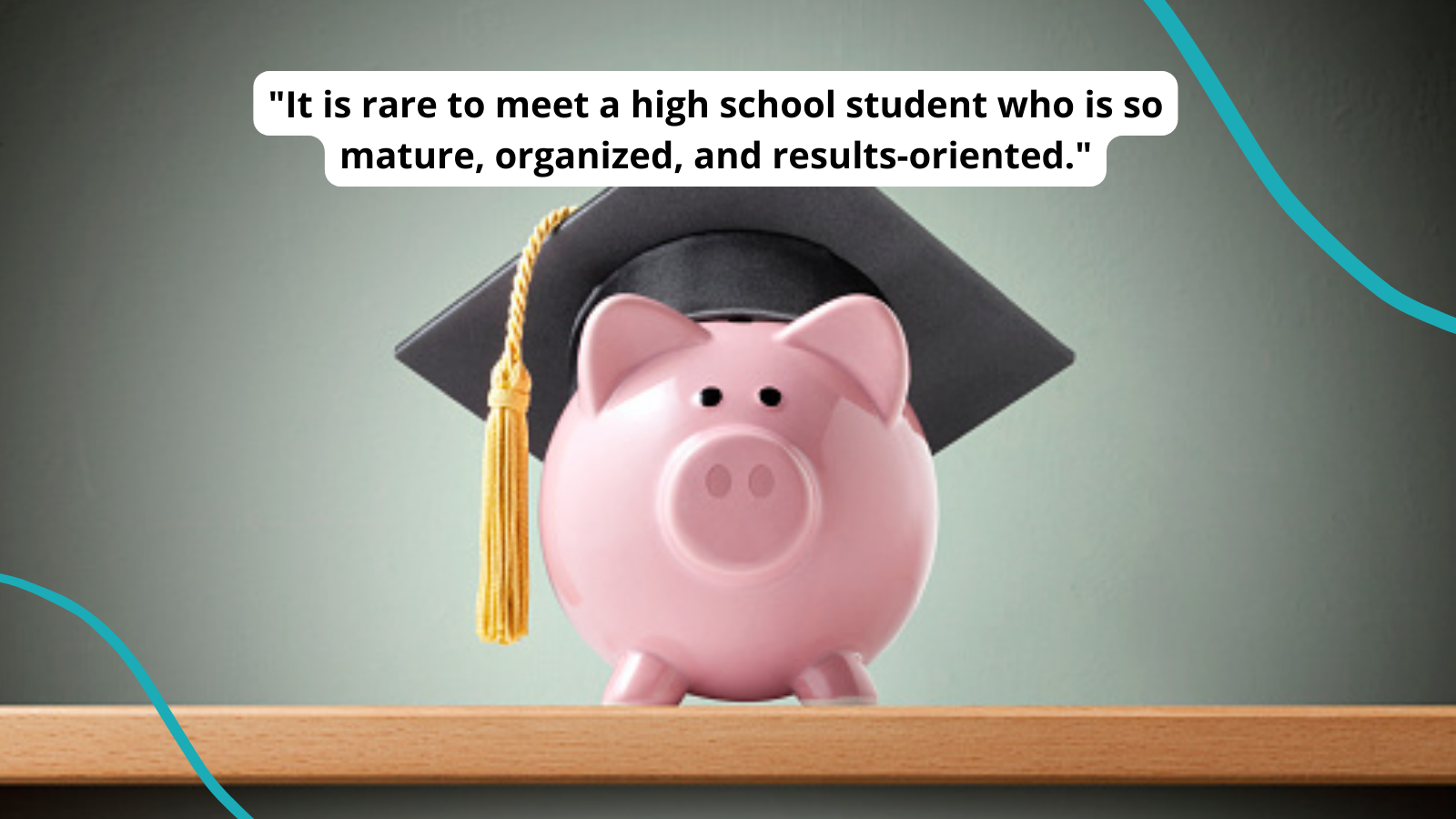
Paying for college takes a lot of planning. Tuition costs rise every year and graduates are buckling under the weight of debt from loans. For some, the expense of higher education is prohibitive, with many talented students being forced to cut their dreams short. Scholarships can make getting a degree more affordable. Students qualify based on academic performance, special interests, or financial needs. If you’ve been asked to help with the process, we’ve got you covered! Here’s a list of sample recommendation letters for scholarship applications that best meet your students’ needs.
How To Write Scholarship Recommendation Letters
If you’ve been asked to write a recommendation letter for your student’s scholarship, you might feel overwhelmed. You want to help your student, but you’re worried your letter won’t be good enough. In the end, you can only do your best, so lead with your heart and consider the following suggestions:
- Use letterhead and add your personal information (full name, title, school name, etc.) in the top left corner.
- Fill the whole page (at least 300 words) with an introduction, two or three paragraphs, and a conclusion.
- In the first paragraph, introduce your student, specify the scholarship for which they are applying, and share details about the nature and length of your relationship.
- In the body paragraphs, describe the ways your student is suitable and deserving of the scholarship.
- In your final section, pull everything together and emphasize your student’s strengths as well as the reasons why you are endorsing them.
Here’s a quick video on how to craft an effective scholarship recommendation letter:
Don’t feel you can honestly provide a positive recommendation? Gently decline their request for a letter. Avoid putting yourself in a position where you will have to be insincere. You don’t want to write something negative because it could cost the student an opportunity to earn a scholarship.
Sample Recommendation Letters for Scholarship Applications
1. general scholarship recommendation letter.
This is a great sample scholarship letter if you’re trying to offer a rounded view of a student’s performance in high school. You’ll include information about your experience with them as well as your thoughts on their potential success in a higher-education setting.
2. Sample Rhodes Scholarship letter
If your student is a candidate for a prestigious award such as the Rhodes Scholarship, this sample scholarship letter will give you an idea of what to share with the selection committee. With these types of recommendation letters, you want to provide as much praise and positive information as possible.
3. Scholarship letter for math students
There are many great scholarship opportunities for strong math students. This sample recommendation letter outlines how to share not only your student’s math talents but the other traits that make them a good candidate as well.
4. Leadership scholarship sample letter
This helpful scholarship recommendation letter offers an example for highlighting leadership skills. Back up your endorsement by sharing specific situations as well as participation in any committees, programs, and events where your student excelled.
5. Scholarship letter for international studies
Does your student plan to go abroad? If so, review this sample for writing a strong letter of recommendation for this specific type of scholarship. Be sure to include evidence as to why you believe your student is well rounded and exceptional.
6. Environmentalist scholarship letter
Has one of your students decided to pursue a degree in environmental sciences and wildlife? If so, this scholarship recommendation letter is a good example because it concisely highlights their strengths and shares why they would make a good candidate.
7. Scholarship letter for students who need financial assistance
No one should miss out on a college education because they can’t afford to pay. You can help them overcome this barrier! This excellent sample letter of recommendation shows the details to include for scholarships based on financial need.
8. Scholarship recommendation letter for STEM students
There are many scholarships for students who plan to pursue a career in STEM fields. If you’ve been asked to write a letter of recommendation for this type of scholarship, this sample will give you a good idea of what to include.
9. Greek society scholarship letter sample
Fraternities and sororities can be a great source of financial support for college and university students. Review this sample recommendation letter for scholarship applications for Greek society candidates.
10. Personal endorsement for scholarships
This sample recommendation letter for a scholarship application is best when you can’t vouch for the prospective student’s academic performance but want to share information about their personal character and how it relates to the scholarship program.
Do you have a great sample recommendation letter for scholarship applications? Please share it in the comments below!
Plus, check out the ultimate guide to college scholarships, want more articles like this be sure to subscribe to our newsletters ..
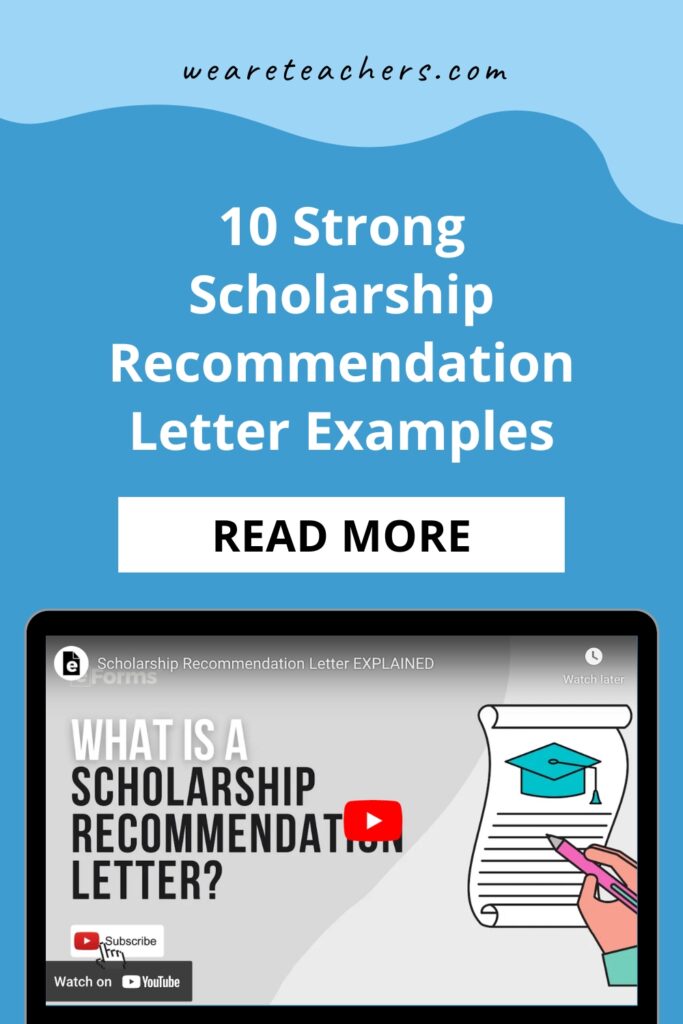
You Might Also Like
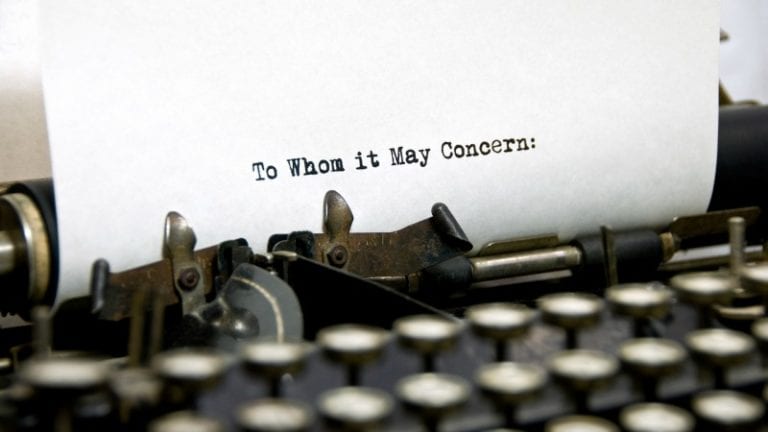
Tips for Writing a Genuine and Powerful College Recommendation Letter
Your words can make a big difference. Continue Reading
Copyright © 2023. All rights reserved. 5335 Gate Parkway, Jacksonville, FL 32256

How To Write a Cover Letter With Examples

Cover letters can help differentiate you from other job applicants and be the determining factor of landing your dream job. By taking the time to craft a custom cover letter, a single sheet of paper can help communicate all the human elements that a resume may fall short of capturing about yourself.
But what do employers and recruiters have to say about how to write a cover letter? What are the best tips they have to offer for graduate students who are writing a cover letter?
We asked 11 employers for their best cover letter tips. Here is what they had to share.
Let it Set the Stage
In many ways, cover letters should provide background information and context to your resume, while simultaneously addressing how that resume addresses the specific requirements of the job opportunity. The cover letter is your opportunity to "set the stage" and to convince the hiring manager why your specific set of skills, experiences and interests will provide value to their team and its objectives.
Andrew Horrigan '11 BSBA (Management Information Systems), Product Manager at Cisco
Research the Hiring Manager
If possible, find out who the hiring manager is and look them up on LinkedIn. Do your research on the company you're applying for. What's their mission statement and how do they portray their company culture? Hopefully what you're looking for in a job is reflected by those things. Make sure the hiring manager knows that and understands who you are and what drives you. A resume is often about as robotic as things can be. Make sure your cover letter is the opposite—personalize it and let yourself shine through.
Joshua Schlag ’05 BS (Computer Science) ’11 MBA, Digital Marketing Manager at Pyramid Analytics
Utilize Career Development Resources
The University of Arizona and Eller College of Management go to great lengths to make sure students are prepared for their impending career journey. Because cover letters are so important to getting your foot in the door, there are several career development resources online and on campus to take advantage of. The university’s cover letter builder serves as a nice template to get started. And of course, it never hurts to make an appointment with an Eller Career Coach through eSMS to have a professional review your letter before submission.
Brett Farmiloe, ’06 BSBA (Accounting), Founder, Featured
Discover Past Samples of the Position
Do your research on the company and personalize your cover letter to the role for which you are applying. Don't be afraid to Google, "How to write a good cover letter for X position." Seriously, it helps! There is so much information out there from various perspectives—applicants, hiring managers, etc. Most importantly be yourself and let your personality come through. And don't forget to spell check!
Mariam Nikola '17 MS MIS, Consultant at Point B
Highlight Your Soft Skills
When writing a professional cover letter, there are a couple things you can do to set yourself apart from the pack. First, make sure you tailor your letter to the specific position you are applying for. This should not be a general, "one size fits all" letter—be sure to discuss specific details surrounding the role or the company itself. Secondly, this is an opportunity for you to show a little bit of your personality. Obviously, you want to remain professional, but this is a great time to highlight some of your soft skills that might not be fully conveyed through your resume.
Brian Ellis ’17 BSBA (Management), Staffing Manager at Randstad Office and Administrative Professionals
Fill in the “Why” Gaps
As a talent advisor, I review a lot of applicants and agree that a cover letter can be a great way to stand apart, if it is done correctly. A great cover letter for me covers the ‘why’ that I cannot understand from just a resume alone. It should clearly state why you are interested in the role, what your goals are for utilizing your graduate degree (if recently graduated) and explain any career pivots reflected on your resume. If you answer those questions in a direct, concise manner it will add value to your application.
Monica Larson , ’11 BSBA (Marketing) ‘20 MBA, Talent Advisor
Tell Your Story
A cover letter is your opportunity to tell your story—tying your experience and personal interests into why you want a position and why you are the best candidate for it. Paint the picture of your journey and what about the position excites you personally and professionally. Similar to your resume, keep it short and sweet. No need to repeat what’s already on your resume. Recruiters and hiring managers don’t have time to comb through a novel, so you need to engage them with as few words as possible while also grabbing their attention.
Kelly Castoro, ’06 BA (Spanish, Portuguese), Project Manager at Squarespace
Tailor Each Cover Letter to the Position You Are Applying
Be sure to research the role and customize your cover letter for each position, relating your experience to the particular role you are applying for. Personalization is key—research who you are sending the cover letter to and address the letter to them directly. End your letter with a call to action, stating you will follow up by phone or email if you haven’t heard from anyone. Follow ups are very important!
Jessica Rosenzweig, ’15 BSBA (Business Management), Account Manager at PeopleWare Staffing
Communicate Bankability and Personality
Your cover letter answers two crucial questions; are you bankable and are you someone the company will enjoy working with? Communicate bankability with your knowledge of the company, industry and why your skills, capabilities and interests are a great fit. Share your passion for their mission, culture, brand—whatever excites you about becoming a member of their team.
When conveyed through a concise, well-formulated, well-worded cover letter, you demonstrate the ability to write an effective business case—communicating that you are a ready professional and worthy teammate who will hit the ground running.
Theresa L Garcia, ’83 BSBA (Human Resources), Senior Change Management and Organization Capability Consultant at Boeing
Keep it Concise but Compelling
A cover letter is your chance to speak directly to the hiring team and tell them why you are not only the best match for the position for which you are applying but also give them additional insight into yourself as an individual that is less visible from your experience.
A great cover letter should be attention grabbing and touch upon the qualities that make you stand out from others in the applicant pool, highlight both your recent and most distinguished accomplishments and drive home why you are the right person for the job. Professionalism is always important, but don’t be hesitant to put your voice into the letter to let your personality shine through. Research the company, understand where they currently are, where they are going and show why you are the right person to get them from point A to point B. Recruiters spend a lot of time reviewing applicants and making yourself stand apart from the crowd is key. Keep it concise but compelling!
Matt Reineberg, ’14 BSBA (Marketing), Senior Talent Acquisition Sourcer at Cox Enterprises
Create your Europass CV
The Europass CV builder makes it easy to create your CV online. You can use it to apply for a job, education or training opportunities as well as volunteering.
The best-known CV format in Europe
The Europass CV is one of the best-known CV formats in Europe. It is easy-to-use and familiar to employers and education institutions.
You will first have to create your Europass profile with information on your education, training, work experience and skills. After you complete your Europass profile, you can create as many CVs as you want with just a few clicks. Just select which information you want to include, pick your favourite design and Europass will do the rest.
You can create, store and share CVs in 31 languages . You can download your Europass CV, store it in your Europass Library share it with employers, with EURES or other job boards.
How to create a good CV
Remember that your CV is your first opportunity to communicate your skills and experiences to a future employer. It is a snapshot of who you are, your skills, your educational background, work experiences and other achievements.
Present your experience clearly
Highlight examples of your skills and experiences matching the job you are applying for. Pay close attention to the details published in the vacancy notice.
Tailor your CV
Make sure you update the ‘About Me’ section to highlight why you are the best person for the job. Do not include a full detailed history. Focus on facts and main points that match the job you have in mind.
Make it readable
Make sure your CV is easy to read. Use clear and simple language. Use strong verbs (e.g. ‘managed’, ‘developed’, ‘increased’).
Use reverse chronological order
Always list the most recent experience on the top followed by previous ones. In case of long gaps in working or learning, include an explanation.
Polish and fine-tune
Check for spelling and grammar mistakes, provide a professional e-mail address, and add a professional photograph of yourself.
Your Europass profile
Your Europass profile is the place to keep a record of all your skills, qualifications and experiences. If you keep your Europass profile up-to-date then you will always have all the information you need to create tailored CVs and job applications quickly.
Good luck with your applications!
Find support through EU services
Eures the european job mobility portal, working abroad in other eu countries, education and training in other eu countries, you may be interested to read.

Create your Europass Cover Letter

Develop your skills through volunteering

Managing your personal information in Europass
Share this page.


VIDEO
COMMENTS
Here's a list of steps you can follow to write a scholarship application letter: 1. Review the organization's requirements. Before you create a draft of your scholarship application letter, consider reviewing the designating body's expectations to familiarize yourself with what they're looking for in a scholarship candidate.
Customize each scholarship application letter. When writing cover letters, it's the little touches that make all the difference. Once you've read a stack of cover letters (like the scholarship committee has), it becomes pretty easy to judge which ones are generic cover letters and which ones have been tailored to an individual scholarship.
Introduction paragraph: State your name, current grade/year in school, intended major, and why you want the scholarship. Share your academic and career goals. Paragraph 2: Highlight your relevant academic achievements like GPA, honors, awards, and advanced coursework. Mention membership in academic organizations.
Summarize your goals and credentials with a conclusion. Restate your interest in the scholarship and why you are a great candidate in the last paragraph of your scholarship cover letter. You can include your contact information and encourage the reviewing committee to reach out to you. This is also a good place to express gratitude for ...
Whether you are writing a scholarship application letter to gain admission to a university or college, appeal for financial assistance, or apply for further postgraduate studies, you can download and use our Free and premium templates and quickly customize them to fit your specific needs and objective. Download our templates today and get ...
The following parts make up an appealing scholarship application letter: First Part. Contact Information. Self Introduction and a Milestone achievement. Middle Part. Key details of you and reason why the committee should choose you. Expression of passion and reason why you want the scholarship. Last Part.
Scholarship Cover Letter Sample First Paragraph—Undergraduate Scholarship. Having been accepted to UT Austin for the 2019 fall term to pursue a Bachelor's in Architecture, I am writing to express my desire to participate in the University Leadership Scholarship Program. You will see that these speak for themselves.
Cover letters should be 1 page long, and it can be beneficial to break them down into small paragraphs to help the reader digest them more easily. They should also include a header with the date, your name and address, as well as your email and/or phone number. After the header, skip a line, and write the date.
The best way to do it is by including "Dear", then addressing the name of the committee with a Mr. or Ms. 3. Opening letter. Now is the time to get into your paragraphs of the scholarship cover letter. In this paragraph, you should make a brief introduction of yourself including your experience.
To help you write, consider the following example of a scholarship application letter: Dear Mr Davids, My name is Richard Scott, and I'm a college student interested in applying for the Creative Arts Scholarship. I intend to attend the University of California, Berkley, and receive a bachelor's degree in graphic design.
To ensure your application stands out, it is crucial to write a compelling and persuasive scholarship letter. Aside from providing evidence of a strong academic record, as well as glowing scholarship recommendation letters from your teachers and coaches, the scholarship letter is arguably one of the most important factors for many students in getting a scholarship.
Writing a motivation letter for scholarship applications takes time and commitment. Plan what you will say in advance, and allow at least three days to write the letter, review it, step away from it and edit it. This extra time will provide the best chance of success with your application. A Sample Scholarship Motivation Letter. Date. Julie Moore
There are three main things that a student must keep in mind when writing a scholarship application cover letter (López, 2017). First, as has been mentioned, is to state why they are deserving of the grant. The second is to use a formal tone. Lastly, it is important to ensure that the cover letter matches the context. 1.
Use this Scholarship cover letter example to finish your application and get hired fast - no frustration, no guesswork. This cover letter example is specifically designed for Scholarship positions in 2024. Take advantage of our sample sentences + expert guides to download the perfect cover letter in just minutes. 4.1.
Writing a compelling scholarship application letter is a crucial step in securing financial support for your education and future career endeavors. By following the key components, tips, and expert advice outlined in this guide, you can enhance your chances of standing out among the pool of applicants and increase the likelihood of being ...
Scholarship Cover Letter Example. To Whom It May Concern, My name is Alex Smith and I am a high school senior in Bend, Ohio. In the fall of 2019, I will be starting my freshman year at the University of Pennsylvania at the Annenberg School of Communication with an intended major in communications.
A fill-in-the-blanks template that will produce your cover letter for scholarship within 15 minutes. Save hours of work and get a cover letter like this. Pick a template, fill it in. Quick and easy. Choose from 18+ cover letter templates and download your cover letter now. Create your cover letter now.
However I have provided motivation letter template below. Use complete title and address. Opening paragraph: Clearly state why you are writing, name the position or type of work you're exploring and, where applicable, how you heard about the person or organization. Make the addressee want to read your resume.
Many scholarships require similar application materials, which commonly include: The application, which can be paper or an online form. Essays, often personal statements, that provide insight into your activities inside and outside the classroom. Letters of recommendation from teachers, coaches, guidance counselors, community members, or other ...
1. General scholarship recommendation letter. This is a great sample scholarship letter if you're trying to offer a rounded view of a student's performance in high school. You'll include information about your experience with them as well as your thoughts on their potential success in a higher-education setting. 2.
Step 1: Access Changes In Your Financial Situation. When schools initially send out their aid offers, they often use a formula to evaluate the family's ability to pay for college. Of course, a ...
Tell Your Story. A cover letter is your opportunity to tell your story—tying your experience and personal interests into why you want a position and why you are the best candidate for it. Paint the picture of your journey and what about the position excites you personally and professionally. Similar to your resume, keep it short and sweet.
The best-known CV format in Europe. The Europass CV is one of the best-known CV formats in Europe. It is easy-to-use and familiar to employers and education institutions. You will first have to create your Europass profile with information on your education, training, work experience and skills. After you complete your Europass profile, you can create as many CVs as you want with just a few ...